#Famous places in Gifu
Text
日本のトリビアまとめ #0018

#Japanese Trivia#岐阜城#Mie famous places#Gifu Castle#三重の名所#Ise Shrine#Famous places in Gifu#白川郷#Okuhida Onsenkyo#岐阜の名所#奥飛騨温泉郷#伊勢神宮#Shirakawa-go#日本のトリビア
0 notes
Photo
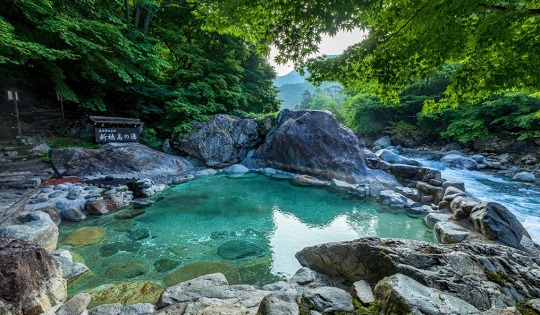
奥飛騨温泉郷
岐阜の名所
奥飛騨温泉郷(おくひだおんせんきょう)は、岐阜県の飛騨地方に位置する温泉地です。豊かな自然に囲まれた山間地域にあり、数々の温泉宿が点在しています。
1. 豊かな自然環境
山々や川が多く、自然に囲まれた静かな温泉地です。四季折々の景色が楽しめ、特に秋の紅葉や冬の雪景色が美しいエリアです。
2. 多様な泉質
奥飛騨温泉郷にはさまざまな泉質の温泉が湧き出ており、疲労回復や美肌効果などが期待できる温泉地です。
3. 宿泊施設
地域内には、温泉旅館やホテルが点在しており、様々なタイプや価格帯の宿泊施設があります。露天風呂や内風呂からの景色を楽しめる宿も多いです。
4. トレッキングや自然体験
周囲にはトレッキングコースや自然遊歩道���多く、自然を満喫しながらの散策やアウトドア体験が楽しめます。
♪♫♬🎤🎹🎶♪♫♬🎤🎹🎶♪♫♬🎤🎹🎶♪♫♬🎤🎹🎶
Okuhida Onsenkyo
Famous places in Gifu
Okuhida Onsenkyo is a hot spring resort located in the Hida region of Gifu Prefecture. It is located in a mountainous area surrounded by rich nature and is dotted with numerous hot spring inns.
1. Rich natural environment
It is a quiet hot spring area surrounded by nature, with many mountains and rivers. It is an area where you can enjoy scenery in all seasons, especially the autumn leaves and the snowy scenery in winter.
2. Diverse spring quality
Okuhida Onsenkyo is home to hot springs of various quality, and is a hot spring area where you can expect to recover from fatigue and beautify your skin.
3. Accommodation
The area is dotted with hot spring inns and hotels, offering accommodation of various types and price ranges. There are many inns where you can enjoy the view from the open-air bath or indoor bath.
4. Trekking and nature experiences
There are many trekking courses and nature trails in the surrounding area, so you can enjoy walks and outdoor experiences while enjoying nature.
0 notes
Photo


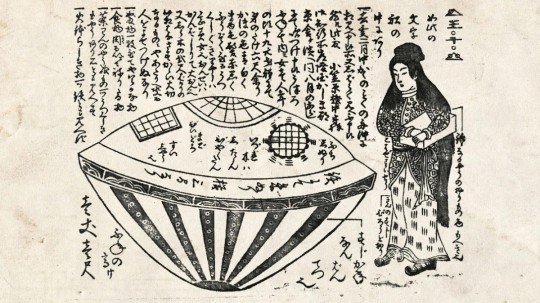
In 1803, a round vessel drifted ashore on the Japanese coast and a beautiful woman emerged, wearing strange clothing and carrying a box. She was unable to communicate with the locals, and her craft was marked with mysterious writing. This story of an utsurobune, or “hollow ship,” in the province of Hitachi (now Ibaraki Prefecture) is found in many records of the Edo period (1603–1868), and Tanaka Kazuo, professor emeritus at Gifu University, has studied the topic for many years. What drew him away from his main research area, applied optics, to investigate this curious episode? And what really took place?
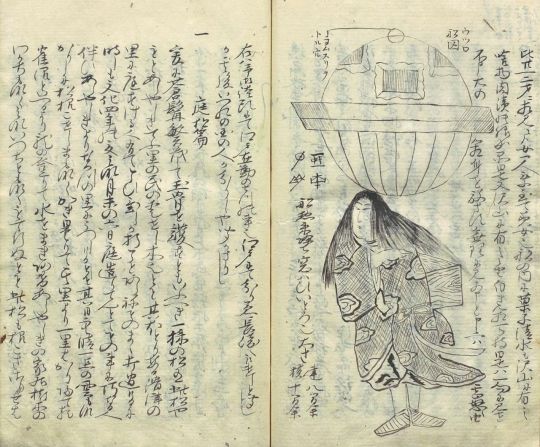
“Like a Flying Saucer”
Tanaka says he began to research the ship after the deadly subway sarin attacks in 1995 by the Aum Shinrikyō cult. “There was a lot of coverage of Aum founder Asahara Shōkō's prophecies and claims to be able to float in the air. Yet the cult’s senior members were part of the scientific elite. I started giving lectures considering paranormal phenomena from a scientific perspective, which meant that I was collecting all kinds of materials for teaching, such as about UFOs in the United States and Japanese folklore. While doing so, I came across the utsurobune legend.” He adds, “Long before the American UFO stories, the craft depicted in Edo-period Japanese documents for some reason looked like a flying saucer. This was fascinating to me.”
UFOs became a modern sensation after the media reported US businessman Kenneth Arnold as having witnessed “flying saucers” on June 24, 1947. A flood of similar stories followed from around the world. Most famously, a UFO was alleged to have crashed to the ground near Roswell, New Mexico, in July 1947. “In the end, though, no wrecks or alien bodies were recovered,” Tanaka says. “There was only the ambiguous testament of witnesses. It was the same with all the other UFO stories from around the world—they were mysteries without any substantial evidence. The utsurobune legend, however, has a number of documents to examine as leads, so in this sense, for researchers it’s a mystery with substance.”
A book published in English by Tanaka Kazuo on his research.
There are similar oral traditions about “hollow ships” across Japan in the Edo period. Tanaka’s research is focused on the various documents that describe the 1803 incident in Hitachi and include illustrations of a beautiful woman and a strange vessel, although they cite different dates. One of the best-known sources is the Toen shōsetsu (Toen Stories), an 1825 collection recording fantastic rumors, which was written by the Toenkai literary circle and edited by Kyokutei Bakin, famous for his lengthy historical romance Nansō Satomi hakkenden (The Eight Dog Chronicles). Others are Nagahashi Matajirō's 1844 work Ume no chiri (Plum Dust), as well as collections like Ōshuku zakki (Ōshuku Notes), Hirokata zuihitsu (Essays by Hirokata), and Hyōryūki-shū (Records of Castaways), which gathers stories of foreign ships washed up in Japan and of Japanese sailors who came ashore overseas.

Picture 1- Hyōryūki-shū (Records of Castaways) by an unknown author. The text describes the woman as being around 18 to 20 years of age, well-dressed, and beautiful. Her face is pale, and her eyebrows and hair are red. It is impossible to communicate with her, so it is unclear where she is from. She holds a plain wooden box as though it is very important to her and keeps her distance. There is mysterious script written in the boat. (Courtesy Iwase Bunko Library in Nishio, Aichi Prefecture)
Pictures 2 and 3- Unknown (maybe Mito bunsho)
Picture 4- From Ōshuku zakki (Ōshuku Notes; around 1815) by Komai Norimura, a vassal of the powerful daimyō Matsudaira Sadanobu. (Courtesy National Diet Library)
Picture 5- From Hirokata zuihitsu (Essays by Hirokata; 1825) by shogunate retainer and calligrapher Yashiro Hirokata, who was also a member of the Toenkai circle. (Courtesy National Archives of Japan)
This post is mostly sourced from nippon.com and japantoday
2K notes
·
View notes
Note
OK, so the upcoming adaptation of the Swordsmith Village arc has me in a chokehold, and as such, I've been thinking a lot about the village itself. I've been wondering- have there been any notable instances of whole villages devoted to Swordsmithing? And as a slight, more KNY tangent, how do you think Gyokko managed to locate the village wherein the story happens? (Definitely could have phrased that more elegantly, but whatevs)
Slight tangent? This like two different questions, Wyn, how sly! Just kidding. Before I get too distracted by SWORDS SWORDS SWORDS, I'm going to set aside the Gyokko question and say I have no idea, maybe Ufotable will give us something come April? Perhaps he's got spying methods through his pots, and one of his pots got sold along the route to the village? Perhaps he sent his fish to spy on the conversations between birds, or perhaps one of his fish got caught and eaten in the village? Perhaps while looking for the Blue Spider Lily, this was a totally accidental discovery? I handled this question in my Demon Sibling AU: Version Uzui as having used ninja abilities to spy on conversations between Kakushi and slayers and crows and used that to piece together a location.
As for swords, instead of villages solely dedicated to sword production, what you often found was neighborhoods dedicated to a certain kind of product--pottery, textiles, oil, etc--and in the case of a town arising around, say, the construction of an emperor's tomb or a Sengoku era castle, what came first was the workers, and then the town to support the livelihood of the workers. For places that are still famous for sword production (or as the case usually is today, kitchen knife production), it was usually a certain part of town instead of the village a whole, or at least, that would be my guess. These craftsman ultimately were taking clients to make their paycheck however much it was that they cared about their craft, but in the case of Kimetsu no Yaiba, the swordsmiths live by a mission, and the village and Corp support them such that they can be single-mindedly devoted to their craft and not have want of economic prosperity. The whole village can and is be built around their work.
And, to make a community around sword production, it typically involved masters of many different crafts--the tatara kiln master who produces the iron, the blacksmith who shapes the blade, the sword polisher, the sword engraver, the craftsman who fits a hilt to it, the craftsman who creates its sheath, and so on. We don't know if every swordsmith in KnY's village can do everything themselves (or perhaps likes doing everything themselves), but with each of them being such strike disciplines, some division of labor and specialization wouldn't surprise me.
Looking back in Japanese history for swordsmiths who produced any any sharp and pretty thing for killing humans as their clients liked, the famous spots various depending on the time period. For example, in the Heian era, the Awataguchi area (the far east end of Sanjo street) of Kyoto was the spot of town to go for finding a swordsmith, though swords produced by masters throughout the country still found their way to the capital too.
Then as we move from Heian through Sengoku, the land of Bizen (modern day eastern Okayama Prefecture) was the top producer of swords in this era, and although Sagami (modern day Kanagawa Prefecture) wasn't as prolific, they had some super famous swords produced there. Mino (modern day Gifu Prefecture) didn't come onto the sword producing stage until later, but they supplied a lot of weapons to Oda Nobunaga and Tokugawa Ieyasu's armies. Although these areas (and many more) become associated with sword production and their own respective styles and aesthetics, they were perhaps better known by the famous individual swordsmiths they produced.
Nowadays, these are considered the "Big Three" spots for Japanese blade production: Sakai City in Osaka Prefecture, Sanjo City in Niigata Prefecture, and Seki City in Gifu Prefecture. I've mentioned Seki on this blog before, as this is where LiSA is from, and I have personal connections there. I haven't been back since long before my KnY obsession, but I can't believe no one ever told me that part of the city's history and took me the museum! There's also a parade in which knife producers walk around and show off their handiwork, while talking about this with a coworker from another part of Gifu, it was as she was saying "it seems scary" that I was like "THAT SOUNDS AWESOME, I WANNA SEE THAT."
I'm also very partial to eastern Shimane Prefecture, not as much known for the sword production as the iron production. Nowdays, Okuiizumo is the only producer of tamagahane (iron ore of the right quality for Japanese swords), and nearby Yasugi is a major producer of high quality steel for everything from industrial use to kitchen blades. Part of what I really wanted to express in my write-up of sword production as it relates to Kimetsu no Yaiba was that you can't focus solely on the swordsmiths and their direct actions on shaping the blade; Japanese swords are product of nature and management of the finite raw materials directly contributes to the beauty of the final product. Even back in the Heian era, these materials would travel long distances to reach the famous hands of renown swordsmiths, and even after the shaping of the blades, they would still be passed around from craftsman to craftsman before reaching the hands of a master swordsman.
22 notes
·
View notes
Text
Onsen Surname Explanations (+ Some First Names)
This explanation is building upon my original post on the now-deleted Tumblr lolyeahshinichi, as well as what people have discovered over the years.
Note some are singular hot springs and some are named after groups of hot springs/hot spring towns.
LOVE!
Defence Club
Hakone:
Hakone Yumoto and Hakone Gora both refer to onsen in...well, Hakone, Kanagawa. There are also train stations named after them. (There also appears to be a place in Nikko which has "Hakone Yumoto" onsen as well, but that would lose the connection with Gora.)
black eggs (kurotama, short for kuro tamago) cooked in hot spring water are a Hakone specialty, specifically at Owakudani.
for some bonus disc content, the Boueibu VAs travelled here + there was a collab with the place.
Yufuin:
In Oita Prefecture.
The namesake onsen is geographically close to Beppu Onsen, although nothing ever seemed to come of this.
Kinugawa:
In Nikko, Tochigi Prefecture.
The name roughly means "angry demon river", yet nothing ever seems to have come of this.
Boueibu did a collab with the place.
Naruko:
In Osaki, Miyagi Prefecture.
Naruko Onsen is known for its ability to cure ailments.
The kanji for Io's name means "sulfur", which Naruko Onsen has (his name is written いお in hiragana, but the characters for "sulfur" are 硫黄 (いおう)).
Zaou:
In Yamagata Prefecture.
The region this onsen is in is known for snow and cherries, specifically Sato Nishiki, which are Ryuu's favourite.
Ryuu's name derives from how rime (a type of ice) makes trees stand up.
Student Council:
Kusatsu Onsen, Arima Onsen and Gero Onsen are known as the 3 best/most famous/major hot springs in Japan (depending on translation).
Kusatsu:
In Gunma Prefecture.
Arima:
In Hyogo Prefecture.
Due to the minerals present, it has "golden baths" (actually a bright mustard/brown colour) and "silver baths" (actually transparent).
Gero:
In Gifu Prefecture.
Has "bijin no yu" ("beauty-enhancing baths"), hence Akoya's obsession with beauty. Bijin is only used to describe beautiful women (vs. bishonen or biseinen), which might explain why Akoya is so androgynous.
Other
Tawarayama:
In Yamaguchi.
Known for healing arthritis and joint pain.
Kinosaki:
In Toyooka Prefecture.
Kou possibly derives his name from the Kou no yu.
Tazawa:
In Aoki, Nagano Prefecture.
Tazawa Masuya is the name of a ryokan.
Beppu:
In Oita Prefecture.
Has various "hells".
Happy Kiss
Defence Club
Shuzenji:
Located in the Tagata district of the Izu Peninsula in Shizuoka.
One of the oldest hot springs.
The resort was loved by Natsume Soseki.
Kirishima:
Located on the hillside of Mt. Kirishima in Kagoshima.
Known for its "Sulfur Valley".
It appears Ryoma got his name because Ryoma Sakamoto stayed in Kirishima with his wife, Ryo, for their honeymoon (apparently the first honeymoon in Japan).
Wakura:
Located on the Nanao Bay in the Noto Peninsula in Nanao, Ishikawa prefecture.
One of the oldest hot springs in the region, with a history dating back 1200 years.
Manza:
In Gunma Prefecture.
Snowy region.
1800 metres above sea level.
Dougo:
In Matsuyama City, Ehime Prefecture.
Said to be the oldest hot spring in Japan, with a history going back 3000 years.
Did a collaboration with Osamu Tezuka's manga Phoenix.
A specialty of the area is Ichiroku tart (a roll cake). Dougo's first name is Ichiro (one-six) to match this and this "Ichiro" sounds like a common name in Japan ("first son" (一郎), although that has an elongated sound on the end). There is also a 6 on Dougo's badge (stylised to look like a cake swirl) and his shirt from when he was younger to play upon this.
Student Council
Ibusuki:
In Kagoshima Prefecture.
Known for sand baths as well as the more traditional hot springs.
Unazuki:
Located in Kurobe, Toyama Prefecture. Found at the entrance of the Kurobe Gorge.
Shirahone:
In Matsumoto City, Nagano Prefecture.
Has milk-white water, due to high magnesium and calcium content. (Shirahone = white bone.)
Other
Karurusu:
In Norioboetsu.
Named after Carlsbad in Czechoslovakia.
Furanui:
Located in Kamifurano, Hokkaido.
Appears to properly be called "Frontier Furanui Onsen".
#boueibu#boueibu hk#Binan Koukou Chikyuu Boueibu LOVE!#Binan Koukou Chikyuu Boueibu LOVE! LOVE!#Binan Koukou Chikyuu Boueibu Happy Kiss!#(This post took me about 2 hours to compile.)
26 notes
·
View notes
Text
InuYasha Wide Edition #4 Translation - Sengoku Period
Original Japanese Scans Provided by Me
Spanish Scans Provided by muffin_0626
Translated by @marusamaa-tradus
Proofread and localized by me
Rules: No screenshots or using my photographs, copy/paste, not using without permission, reblogs/linking only

SENGOKU PERIOD
A chaotic world where fights didn’t cease
Normally, “Sengoku Period” references the period after the Onin war in 1467. There are two theories about this period: the first one suggests that it ended in 1568, when Oda Nobunaga got in Kyoto; in the other the periods Shokuho, Azuchi, Momoyama and even the Battle of Sekigahara and the siege of Osaka are included. It was a chaotic era during which battles between daimyou (1) were common and there was uncertainty about where and when a war could start. The name “Sengoku Period” was put by the kuge (2) of that time, who were inspired by the “Shunju Sengoku Period” of China.
⦁ Feudal lord.
(2) Aristocracy in the imperial court.
A period where no one held absolute power
It is thought that the period of Inuyasha is 1540s, during which Oda Nobunaga was called “idiot of Owari”. By that time the power of general Ashikaga’s family had weakened and the political power was passed to administrator Hosokawa. However, battles to obtain the rule didn’t cease and Japan had become a state without an absolute ruler. The privileges granted in the Muromachi Period were no longer valid and a time came where “gekokujou” was practiced, which means the daimyou’s subordinates could rise to power.
Later, there was a series of conflicts in several places. Famous daimyou of the Sengoku Period, such as Shingen Takeda, Kenshin Uesugi, Ujiyasu Hojo, among others, began to participate actively.
(Page 2)
An outlaw period where the greedy could be successful
The warrior groups that fought over power
During the Sengoku Period, the world was changing into a society where the most important thing was the capacity of each person. Instead of the mandated daimyou, who were chosen by the Muromachi government, the “shugodai” were the ones with control over the lands. Besides, commoners could become daimyou. A classic example is Dozan Saito, who was nicknamed “the Mino rattlesnake”. During his childhood, his name was Minemaru and he became a monk in Kyoto. After that, he became secularized in Mino (currently the prefecture of Gifu), he married an oil merchant’s daughter and lived as such. However, with the resolution of being successful, he studied the art of war and became Mino shugodai’s vassal.
Later, he snatched his power and practically took over Mino. This is a classic example, but at the same time it proves that people with a great ambition could reach power using their ingenuity, therefore battles between warrior groups were very frequent. On the other hand, warriors who had lost their lord became bandits.
The “chimi mouryou” that frightened humans
The Sengoku Period, where Inuyasha and his companions live, was a period where demons did their thing. It is said that their number grew approximately 500 years before this period, during the era when nobility held power, when many people died because of famine and wars. Demons lived hiding in nature with other beings such as spirits. They had many characteristics: they could be shy and harmless, or so aggressive to the point of devouring the body and soul of humans. There was a wide variety depending on their abilities and intelligence. It is said that the more they look like a human, the more dangerous they are...
In the region where InuYasha and his friends live, there was a job called “Demon Slayer” and some monks were asked to defeat them...
(Page 3)
As we can see, demons were very present in the life of the humans and were a nuisance for them. However, some of them tried to make use of the power of the demons. Bandit Onigumo, who wasn’t able to move because of the burns and fractures in his body, sells his soul to demons so that he can have the beautiful priestess, Kikyou. However, as a result, his body and his soul were eaten by demons. It’s difficult to control them without enough strength. Kikyou uses the demon Shinidamachu with her great high-level spiritual energy to collect the souls of the deceased, but this is possible because she possesses a strength greater than the demons’. This also means she could frighten some people. Basically, demons were fearsome creatures for humans during this period.
The great uncontrollable nature
During the Sengoku era, people lived face to face with nature, that’s why the displays of its strength, such as tornadoes, great winds and rain, were something uncontrollable. Humans had to accept the damage caused by nature in a passive way or pray to gods like Suijin (1) and Ryujin (2). Sometimes they received its blessings, like harvests, but other times they received its damage. They were face to face with it because they didn’t try to dominate it, but to live with it.
⦁ Water god
⦁ Dragon god
Normal people who lived vigorously
Persons lived in a vigorous, strong way despite the incessant wars, fearing demons and feeling helpless/powerless when it came to nature. The existing shoen (1) system collapsed and the economy grew quickly because the new landlords and merchants used new land. Besides, with no exception, the most influential daimyous had great economic power. The clearest examples are Shingen Takeda, who worked a gold mine, and Oda Nobunaga, who inaugurated the Rakuichi Rakuza (2). The Sengoku era, where people’s morals were low, was an era of freedom where the talented could thrive.
⦁ Something like a private independent state that was tax-free and that existed between the 8th and 15th centuries in Japan.
⦁ Economic program of the second part of the Azuchi Momoyama period consists of creating a market that is more open.
(Page 4, interview with Rumiko Takahashi)
-I wanted to create an action adventure-
Regarding the starting point of the creation of the story, until then I had just written comedies, that’s why I wanted to write something with a story that wasn’t necessarily a comedy. Moreover, I wanted to create an action adventure set in the Sengoku era. I always liked kimono and Japanese clothing, that’s why I wanted to write this story. Thus, swords are also important, that’s why it would be an action story. In “InuYasha” Japanese clothing is always present.
-My first long story without “comedy”-
Among all the stories written until that point, “Urusei Yatsura” is a science fiction story that takes place in no particular country, and “Ranma 1/2” has a Chinese touch, so on this occasion it had to be something Japanese, right? Plus, I needed a change of setting. I think every story has different readers, that’s why I wanted a different setting from “Ranma 1/2”, that was my previous work, and something less comedic, even if “InuYasha” is not a comedy. But I also thought that readers maybe wanted something “comedic”. There was an episode at the beginning of “InuYasha” for which I was scolded by a reader because they couldn’t laugh. They said my jokes “weren’t funny”. They probably expected a funny story, but were disappointed after reading it. Maybe it was risky to change my style after “Ranma 1/2” but I thought it wasn’t so serious because “I only wanted to write something Japanese”.
-The Sengoku period is a free setting-
When I started drawing the Sengoku period, I noticed that the castles previous to Nobunaga have a lack of tenshukaku (1), that’s why they’re more difficult to identify as castles, but it can’t be helped. In addition, to portray the daily life of the villagers I checked old records and drawings. I don’t know if they’re correct regarding the historical period, but they should be more or less correct. You have to be flexible. I’ve never mentioned the exact year of the era. Besides, I think the Sengoku period is a very free setting for a manga.
⦁ The highest tower in a Japanese castle

Spanish Transcript
WIDEBAN VOLUMEN 4 - PERÍODO SENGOKU
Un mundo caótico en donde las batallas no cesaban
Normalmente con “Período Sengoku” se hace referencia a la época posterior a la Guerra de Onin de 1467. Existen dos teorías acerca de este período: una propone que esta época acabó en 1568, cuando Nobunaga Oda entró en Kyoto; en la otra se incluyen los períodos Shokuhou, Azuchi Momoyama e, incluso, la Batalla de Sekigahara y el sitio de Osaka. Fue una época caótica durante la cual fueron frecuentes las batallas entre los daimyou (1) y existía una incertidumbre acerca de que en cualquier lugar y momento podría empezar una guerra. El nombre “Período Sengoku” fue puesto por los kuge (2) de aquella época, quienes se inspiraron en el “Período Shunju Sengoku” de China.
Un período en el que no existía un gobernador absoluto
Se piensa que la época de Inuyasha fue la década de 1540, durante la cual Nobunaga Oda era llamado “idiota de Owari”. En ese entonces se había debilitado el poder de la familia del general Ashikaga del Período Muromachi y el poder político había pasado al administrador Hosokawa; sin embargo, las batallas para ganar el poder no cesaban y Japón había pasado a un estado en el que quedó sin un gobernador absoluto. Los privilegios que otorgaba el Período Muromachi habían desaparecido, y llegó la época en donde se llevaba a cabo el “gekokujo”, la cual era una práctica en donde los subordinados del daimyou podían escalar al poder.
Luego hubo una serie de conflictos en varios lugares. Daimyou famosos del Períodos Sengoku, como Shingen Takeda, Kenshin Uesugi, Ujiyasu Hojo, entre otros, comenzaron a participar activamente.
(pág 2)
-Una época sin ley en donde los ambiciosos podían triunfar-
Los grupos guerreros que peleaban por el poder
Durante el Período Sengoku el mundo se estaba transformando hacia una sociedad en donde lo que más importaba era la capacidad de la persona; en lugar de los daimyou encargados, quieren eran elegidos por el gobierno de Muromachi, los “shugodai” (3) eran quienes prácticamente tenían el control de las tierras, además, hubo individuos que, siendo plebeyos, llegaron a ser daimyou. Como un ejemplo clásico de quien ha escalado al poder se encuentra Dozan Saito, quien tenía el apodo de “la víbora cascabel de Mino”. Su nombre de la infancia fue Minemaru y a los once años se convirtió en monje en Kyoto. Posteriormente se secularizó en Mino (actual prefectura de Gifu), se casó con la hija de un negociante de aceites y vivió como comerciante de tales. No obstante, decidido a ser exitoso, estudió el arte de la guerra y logró ser el vasallo del shugodai de Mino.
Después arrebató el poder de la familia y, prácticamente, se adueñó de Mino. El ejemplo de Douzan Saito es clásico, sin embargo, muestra cómo durante el Período Sengoku las personas con una gran ambición podían escalar al poder usando su ingenio y, por ello, las batallas entre los grupos guerreros abundaban por doquier. Por otro lado, algunos guerreros que habían perdido a sus amos se convirtieron en bandidos, pues las leyes ya no existían.
El “chimi mouryou (4)” que atemorizaba a las personas
El Período Sengoku, donde se encuentran Inuyasha y sus compañeros, era una época en la que los youkai hacían de las suyas. Dicen que estos aumentaron su número aproximadamente 500 años antes de este período, en la época en la cual los nobles tenían el poder, cuando muchas personas fallecieron a causa de hambrunas y guerras. Los youkai vivían escondidos junto con otros seres, como los espíritus, en el interior de la naturaleza. Tenían varias características: podían ser tímidos e inofensivos, o tan agresivos que incluso podían devorar el cuerpo y el alma de los humanos. Había una gran variedad de ellos en cuanto a sus habilidades e inteligencia. Se dice que son más peligrosos mientras más similitudes tengan con la apariencia humana.
En la región en donde viven Inuyasha y sus compañeros había un oficio organizado de “caza youkai” y también monjes a quienes se les pedía que derrotaran a los youkai…
(pág 3)
Podemos ver que los youkai estaban muy presentes en la vida de los humanos y eran una molestia para ellos. No obstante, también hubo quienes trataron de usar los poderes sobrenaturales de los youkai. El bandido Onigumo, quien no podía moverse por las quemaduras y fracturas de todo su cuerpo, vende su alma a los youkai para poder tener a la bella miko Kikyo. Sin embargo, como resultado, su cuerpo y su alma fueron devorados por los youkai. Es difícil manejar a los youkai sin tener la fuerza suficiente. Kikyo usa al youkai Shinidamachu con su energía espiritual de alto nivel para reunir las almas de los fallecidos, pero esto es posible porque ella tiene una fuerza extraordinaria mayor a la de los youkai. Esto también significa que ella podría atemorizar a algunas personas. Básicamente, los youkai eran criaturas temibles para los humanos en el Período Sengoku.
La gran naturaleza incontrolable
Durante el Período Sengoku las personas vivían cara a cara con la naturaleza, por ello las muestras de su fuerza, como los tornados, los fuertes vientos y las lluvias, eran algo incontrolable. Las personas debían aceptar los daños que ella provocaba de manera pasiva o rezar a los dioses, como Suijin (5) o Ryuujin (6). Las personas vivían al lado de la naturaleza: a veces, recibían sus beneficios, como la cosecha, pero otras, los daños que causaba. Estaban cara a cara con ella, pues no trataban de dominarla, sino vivir con ella.
Las personas comunes que vivían vigorosamente
Las personas del Período Sengoku vivían de una manera vigorosa y fuerte, incluso siendo sacudidas por las interminables guerras, temiendo a los youkai y viéndose impotentes ante la naturaleza. El sistema de shoen (7) existente hasta ese momento se derrumbó y la economía creció velozmente, pues los nuevos terratenientes y comerciantes explotaron nuevas tierras. Además, sin excepción, los daimyou más influyentes tenían un gran poder económico. Los ejemplos más claros son los de Shingen Takeda, quien explotó una mina de oro, y Nobunaga Oda, quien inauguró el Rakuichi Rakuza (8).
El Período Sengoku, en donde la moral era baja, fue una época libre durante la cual las personas con talento podían florecer.
(pág 4 - entrevista)
Quería crear una “aventura con acción”
Acerca del punto de inicio de “Inuyasha”, hasta ese entonces sólo había escrito comedias, por eso quería escribir algo con historia. Deseaba escribir algo que no necesariamente fuera una comedia. Además, quería crear una “aventura con acción” del Período Sengoku. Siempre me han gustado el kimono y la vestimenta japonesa, por ello quise escribir esta historia. Entonces las espadas también resultan importantes, por eso sería una historia de “acción”. En “Inuyasha” siempre estará presente la vestimenta japonesa.
Mi primera historia larga sin “comedia”
De entre las historias que había escrito hasta ese entonces, “Urusei Yatsura” es una historia de ciencia ficción, sin un país particular, y “Ranma ½” tiene un toque chino. Entonces en esta ocasión debía ser algo japonés, ¿no? Además, quería cambiar un poco el ambiente. Creo que en cada historia hay diferentes lectores, por eso deseaba un ambiente diferente al de “Ranma ½”, que fue mi historia anterior, y que fuera menos cómico. Aunque “Inuyasha” no es una comedia. Pero también pensé que los lectores quizás querían algo “cómico”. Hubo un episodio en donde al comenzar la serie de “Inuyasha”, un lector me regañó porque no podía reírse. Dijo que mis chistes “no eran buenos”. Seguramente esperaban de mí una historia graciosa, pero se decepcionaron al leerla. Tal vez fue un riesgo cambiar mi estilo desde “Ranma ½”, pero no creía que fuera tan grave, pues “solo quería escribir algo japonés”.
El Período Sengoku es un escenario libre
Cuando empecé a dibujar el “Período Sengoku”, me percaté de que los castillos anteriores a Nobunaga carecen de tenshukaku (9), por ello al dibujarlos son difíciles de identificar como castillos. Pero ni modo. Asimismo, para plasmar la vida cotidiana de las personas de la aldea, veía registros y dibujos antiguos. No sé si sean correctos en cuanto a la época, pero más o menos deben estar bien. Hay que ser flexibles. Nunca he mencionado el año exacto de la época. Además, creo que el Período Sengoku es un escenario bastante libre para un manga.
NOTAS:
1- Señores feudales.
2- Aristocracia de la corte imperial.
3- Representantes oficiales de los feudos cuando el shugo, el gobernador, no podía ejercer su poder muchas veces por estar alejado de su tierra.
4- Monstruos/demonios que habitan tanto en tierra como en agua.
5- Dios del agua.
6- Dios dragón.
7- Especie de estado privado exento de impuestos y autónomo que existió entre los siglos VIII y XV en Japón.
8- Programa económico de la segunda parte del Período Azuchi Momoyama consistente en crear un mercado más abierto.
9- Estructura arquitectónica de los castillos japoneses. Es la torre más alta del castillo.
35 notes
·
View notes
Text
Finding Home- Dabi x Fem! Reader
This is my submission for Day 6 Places of @konoblog-simps server collab
Warning: Angst, Lots of Fluff, Soft Dabi
WC:2k
Leaving everything behind was the best decision he’d ever made. He was finally free, especially after emptying the bank account his father had for him. Nothing was holding him back. The few days after the big fight the anger was still there. It didn’t come to any physical blow but felt as if there had been. There was no looking back now, he will no longer be the unwanted son. He could change his name, his personality, and his whole story. He could be the person he truly wanted to be.
His first destination was the small city of Takayama in the Gifu Prefecture. The city always held a special appeal to him since it was known for the olden style of Japanese Culture. Something he’d always been interested in since a young boy. He stayed at the Hida Takayama Hostel for a few days. On the last night, he decided to stay at the Takayama Ouan with its breathtaking view of the city. It was here where the two of you met. Both of you spent your time talking about your future dreams and plans, and just enjoyed one another’s company.
The next morning he was planning on moving to a small picturesque town in the southern islands of Japan. ‘It was the perfect beginning to his new life.’ he told you. You decided to join him before continuing your next adventure. Here, the two of you spent two days watching the perfect sunsets the beach was named after. Most people didn’t pay any attention to you both assuming you were lovers lost in the moment.
You two exchanged numbers, in case your paths were fated to cross again. He left for Singapore, and you to South Korea. The few days spent with you left a wonderful impression on Dabi. The following days since Japan Dabi couldn’t stop thinking of you. The way your face lit up when talking about something you were passionate about, or the way you giggled when you were excited. It was those honest and earnest emotions from you he truly enjoyed. The memories helped him on the long and tedious train ride from Singapore through Malaysia. He got off a few times to get food or walk around.
Every stop he thought of calling or texting but restrained himself from doing so. He didn’t want to seem needy or clingy. A week later, when he was staying at a little hostel in Kluang in Malaysia, sipping on the most delectable cup of coffee when his phone chimed from you. You had sent greetings and wished him well. You had traveled through Russian and sent pictures of yourself at the Kremlin. How happy you looked in your picture. He wished he would’ve just joined you at that moment. He sent back well wishes and shared that he was currently enjoying a cup of coffee, with the promise to be the first one to text next time.
As the world trek continued for him, he found himself wandering through China trying all the delicacies he had heard about as he traveled. He spent a few days looking at the pandas, walked along the Silk Road, and saw the Terracotta Army before making his way through Mongolia, and taking in the breathtaking scenery of the grasslands. From Mongolia, he headed to Russia.
When he arrived at the Kremlin in Moscow, he stood exactly where you did, and snapped an identical picture to yours. He texted it to you as soon as he took it. He wore a small smile. You had texted him you were enjoying the beautiful colors of the Grecian seas, and how delectable the food was. He promised to visit Greece as soon as he could but had wanted to visit Mumbai, India first. You smiled knowing that you weren’t truly on this trek alone.
A few weeks had passed after the last text. You decided to text him to check on him. You found out he had been to see Mumbai, and sat on the famous Konkan coast. He also went to Jaipur to try Rajasthani cuisine and the street food in New Delhi. From there he went to Greece to learn and see the architecture of Athens, see the beautiful city of Santorini and see the first university in Greece.
He currently was in Lyon, France, while you were staying in Paris. He had plans to come to Paris in a couple of days. You made plans with him to meet in three days in Paris at a little restaurant called La Maison Rose in Montmartre. You were excited to see him, to say the least. You spent that morning going through all of the clothes you packed only to choose basic black slacks and a black shirt.
When you arrived you saw Dabi sitting at a table he definitely stood out against the Pink building. Your breath caught in your throat looking at him. When he looked up he saw you smiling. You knew that most people stared at him most of the time, and he did a good job ignoring them most of the time. However, with you, he seemed to fidget under your gaze. You weren’t sure if it was because you made him uncomfortable or if he was just like that.
“Hello, Y/N.” He greeted you with a kiss on each cheek. You felt electricity run through your body.
“Hello, how have you been? How is your trip going?” You asked with excitement. The two of you shared the highs and lows of your adventures, the pictures, and every ridiculous story you could. When the day got later you and Dabi grabbed dinner and wine. The feel of the city may have gotten to you, or perhaps it was the alcohol. You took Dabi back to your room and participated in evening affairs, as two lovers would do. This continued for another week. Waking up in his arms, enjoying the Parisian life with tourist flair, and getting to know another human through scandalous endeavors, and philosophical discussions post-coitus were the highlight of your time together.
You two had not discussed what would happen afterward, but deciding to part ways was a mutual agreement. You traveled south to Portugal and Spain, and he went north to the UK, Scotland, and Ireland. Another month had passed before you two had contact. For you, it wasn’t the most wonderful of occasions, but the positive pregnancy test you held in your hand deemed the matter important enough. You hoped he would be some sort of knight in shining armor, but you didn’t put a lot of faith in it. When you reached his voicemail all hope deflated, and you abruptly ended your trip and headed home.
Two more weeks had passed, and while you were still debating on the fate of your unborn child, you wondered what Dabi was up to. After his time in Morocco, he had traveled to Johannesburg, Durban, and then Cape Town in South Africa. When he was finally able to charge his phone properly for more than an hour, he heard your voicemail. His first thought was to call back since it had been two weeks since you had left the voicemail. You didn’t leave any clues or hints to the importance of your message, but you knew he’d call when he could.
It was early when you received his phone call you were in the middle of getting ready to work. You picked it up assuming it was your mother asking you to run an errand after work for her, or your boss asking you to work another double shift today. When your eyes looked at the name on the screen, your heart stopped for a brief second. You grew more and more nervous as you brought the phone to your ear. Without thinking, you pressed the green button.
“Hello.” Dabi’s voice said on the other line. “Hello? Y/N? Can you hear me?” His voice melts your insides. You thought back to the week you spent in Paris together tangled up in one another not caring about anything else.
“Hello?” You finally said into the phone.
“Hey, I am sorry about not calling you back sooner. I haven’t been able to charge my phone properly for some time. How are you doing? How’s your trek going?” His voice seemed light and carefree with a hint of exhaustion.
“Yeah. I am good. I have been back home for about 6 weeks.” You told him as nonchalantly as you could.
“Is something wrong? Are you okay? I thought you had another two weeks left?” His voice was gentle and full of surprise.
“Actually, I have something to tell you. The reason I ended my trip so abruptly was that I found out I was pregnant.” You felt nauseated from telling him. On the other line, you heard some shouting.
“Sorry, Y/N. I have got to go, but I will call you again as soon as I can.” Dabi rushed to say before hanging up the phone. The news hit him like a ton of bricks. He couldn’t remember exactly where you said you were from. He hoped he could find you on any social media site and figure it out from there. After an hour of searching, he figured out you lived in a small town in California. He immediately booked a flight to the closest Airport and hoped that would be enough.
Three days later without any phone calls or news from Dabi, you gave up. You figured that if he really cared, he would’ve called, or at least text you. You were in the middle of your day off when you heard the doorbell ring. Your mother was home for the day and you let her answer the door. From your room, you heard a deep voice speaking with your mother, but you couldn’t make out the words.
“I am very sorry ma’am, I was hoping to find Y/N here, but it seems I have the wrong house. Have a pleasant day.” Dabi spoke and turned around to leave. You rushed down the stairs and saw him.
“Dabi!” You cried out. He lifted his head at the sound of your voice. You tore down the stairs and straight into his arms. You hugged him as hard as you possibly could. You were astonished to see him standing before you, you started to cry. He wrapped his arms around you and buried his face in your hair. He stood and let you cry. Your mom walked away to let you two have a moment. After some time, you seemed to have calmed down. Dabi got down on one knee and proposed to you. You happily agreed.
In the months following, Dabi found a full-time job and rented an apartment for the two of you and the baby. You had a small wedding with your family present. A couple of years after the baby was born and you felt more stable, you planned a vacation for the three of you. You wanted to surprise Dabi and try to reconnect him with his family. After many phone calls to his parents when he wasn’t home. The three of you made your trip back to Japan. You thought back to where it all began on that serendipitous meeting. When you arrived at the airport you were met with open arms from Dabi’s family. You learned about his life growing up and his real name, which you promised to call him only when he was in real trouble.
In a quiet moment alone, Dabi took you aside, kissed you passionately, and thanked you for bringing him home to his family. A few days later, his mother and father thanked you as well. They loved seeing him as a loving husband, and doting parent, but most importantly you brought him back to them. Now their family was whole again.
45 notes
·
View notes
Text
Commonality of Buck-Tick member names
I was thinking that if you’re not Japanese, you might not know how common or rare the various Japanese names are. For Buck-Tick, the names of the band members are fairly common first names and surnames, not really anything unusual happening there. No native speaker should have trouble reading their names. However, the most interesting thing to note is that Hisashi’s kanji is not usually how one would think to read that name, which is how it ended up that on their very first release on an independent label, his name was typo-ed as Kotobuki instead of Hisashi. (To keep that kanji and reading, it is likely to add one more kanji to make Hisashi, much like how Atsushi’s name is 2 kanji.) Our Hisashi Imai is not the only one with that kanji and name reading, but it’s not the default way to read it. This is why when you fill out forms in Japan, you not only write your name’s kanji but you also write down how to read it because you never know what combos a parent came up with.
Some basic info about their surnames, such as how common it is and where in Japan is it most common. Excluding Hokkaido and Tokyo as the majority of people who live in those two places are “immigrants”, so to speak, and not native for several generations. (If you meet someone from those 2 places, ask them where their grandparents are from.) I need you to be able to track your family history in that general area for at least 150-200 years in Japan to call you a native of that region, sorry. (If you can’t claim that you’re the 19th generation descendant of so-and-so, what is your worth?) This sort of tracking is quite easy to do in Japan because we have family registry books that note the genealogy (patriarchal because who needs to remember the names of women) and also serves as a way of establishing citizenship. It’s also fairly common IMHO for the history of a surname to be like, well 1000 years ago this person did something good for the emperor/king so they were granted a gift and the gift was this name and some land. But, I digress. (Trust me, this whole paragraph is hilarious if you’re Japanese with a sense of humor because it’s true.)
Focusing on family names here. No info on their first names as I looked up what were the most common names given to boys in the years the members were born and though their names are common enough, only one of the members have a name in the top 10 most popular boys names for the year they were born. Takashi (same kanji as B-T member; real first name of Toll) was the 9th most common name given to a boy in 1962 (same year as Takashi the drummer). Yutaka gets an honorable mention. Yutaka (same kanji as B-T member) was the 3rd most common name given to a boy in 1962 and 1963; the 6th most common name given to a boy in 1964; the 7th most common name given to a boy in 1965 (Yutaka the bassist was born in 1967). Minor note: though the kanji is different, Atsushi was the 10th most common name given to a boy in 1968 (Atsushi the singer was born in 1966). To the rest of the band members, don’t feel so bad as my name isn’t in the top 10 either! And who can even read child names today. It’s crazy, right? (mic check, um, can I get a chuckle?)
What is not so commonly shared and do not expect to ever know this stuff is the family crest. The family crest is VERY specific to the son that you descended from. Japan be like, “We can’t have each of George Foreman’s kids named George AND have the same family crest!” This ain’t no google search thing. This ain’t no ask a librarian. This is in the family genealogical book and the only people who get to see that is family. Sure, there’s crests online. But don’t think that’s your crest or your favorite celebrity crest. That’s just some common crest that made it’s way to a scanner. Also, if you study a craft, it could be that craft is from a “school” that passes on a pseudonym once you’ve mastered the craft, complete with kanji and crest so unless you know the master’s birth name, you’re not even looking in the right direction. Example, one year someone with the same family name and kanji as mine got really famous in Japan and even made international headlines. Like, you’ve probably heard of this person famous. My mom was curious if we’re related (internet says there’s only 5400 of us so maybe) and while she was visiting relatives, happened to find out that we have different family crests, thus she gave up the search and declared we are not related. (She did not want to bother to go back 19 generations or so to the story of the king who passed out names.., see paragraph 2 above.)
On to the names! For reference, all Buck-Tick members are from Gunma prefecture. Japan has a population of 126,476,461 people. The most common surnames are Satō, Suzuki, Takahashi, Tanaka, Itō, Watanabe, Yamamoto, Nakamura, and Kobayashi. Each of those surnames have over 1,000,000 people with that name residing in Japan. What’s a rare surname? Something with either 1 or 4+ kanji. (Except Hayashi.) They exist but. Really rare surnames? Well, those would be the names the Japanese government declared cannot exist anymore so those names tend to exist only outside of Japan. (Happened to one part of my family so I know this shit exists. Only 460 left. How did they get away with it? And how can I get hanko with this?)
Name info source: https://myoji-yurai.net/
桜井 (sakurai)
literal meaning: cherry blossom-well (like a water well)
This kanji for Sakurai is ranked #106 for most common surnames in Japan. This is the most common kanji for Sakurai. It is commonly found in Kanagawa, Saitama, and Chiba prefectures. (Kanto region) For cities, Takasaki, Gunma and Uonuma, Niigata have the most people named Sakurai. Roughly 172,000 people in the entire nation are named 桜井. In Gunma, almost 5% of Kanna town has this surname. Other famous Sakurais? Argh, someone in The Alfee. Better than that, Ao from Cali≠Gari.
櫻井 (sakurai)
Same name as above, just different cherry blossom kanji (older version). This kanji for Sakurai is ranked #813 for most common surnames in Japan. It is commonly found in Kanagawa, Aichi, and Chiba prefectures (Kanto and Chubu regions) For cities, Takasaki, Gunma and Akashi, Hyogo have the most people named Sakurai. Roughly 23,600 people in the entire nation are named 櫻井. (The people who couldn’t be sussed to simplify their kanji.)
今井 (imai)
literal meaning: now-well (like a water well)
This kanji for Imai is ranked #75 for most common surname in Japan. This is the most common kanji for Imai. It is commonly found in Kanagawa, Saitama, and Aichi prefectures. (Kanto region) For cities, Gero, Gifu and Ichinomiya, Aichi have the most people named Imai. Roughly 212,000 people in the entire nation are named 今井. In Gunma, 20% of Ueno village has this surname. Other famous Imais? Miki Imai, singer, wife to Tomoyasu Hotei.
星野 (hoshino)
literal meaning: star-field
This kanji for Hoshino is ranked #147 for most common surnames in Japan. This is the most common kanji for Hoshino. It is commonly found in Gunma, Saitama, and Kanagawa prefectures (Kanto region). For cities, Kiryu, Gunma and Nagaoka, Niigata have the most people named Hoshino. Roughly 137,000 people in the entire nation are named 星野. In Gunma, almost 36% of Katashina village has this surname. Other famous Hoshinos? Gen Hoshino wrote a song during the pandemic that got very popular and even Hisashi Imai posted a video of him playing along to that song.
樋口 (higuchi)
literal meaning: gutter-mouth
This kanji for Higuchi is ranked #132 for most common surnames in Japan. This is the most common kanji for Higuchi. It is commonly found in Fukuoka, Osaka, Niigata, and Kanagawa prefectures (Kansai to Chubu regions) but it’s safe to say it is common throughout all of Japan except for Okinawa. Roughly 146,000 people in the entire nation are named 樋口. In Gunma, there’s roughly 1,000 people named Higuchi in Takasaki and guess where our bassist is from. Other famous Higuchis? How about Yutaka Higuchi the figure skater.
Yagami...the stage name of the drummer. He never writes this in kanji but I imagined that if he did, he would write it as 八神. Or did he write it like that once so that’s why I imagine it that way? Anyway, there’s many possible kanji variations and I was surprised that the most common way to write it is actually 谷上. (For me, I’m like is that Tanuye? Taniue? because I’m Okinawan and we have weird place names.)
38 notes
·
View notes
Text
Revi-Revi-Revi! Revi-Revi-Revi! Revi-i-ve Shi-ppu! Shippu~!
Yeah I know that's pretty obvious, but hey! Revice Ep. 15 is out! I'm gonna get all the obvious jokes I can out before things go horribly, horribly, horribly wrong!
Spoilers, I guess...
-OH, I SEE. She's the only sacrifice while the rest of you chumps get to rule over everyone else with Gifu. ...y'know, maybe you should've kept this under wraps, just saying. You guys are dumb cult leaders.
-Kick his ass, Julio!
-"Atemi!"
-Oh yay, it's Christmas~!
-OH FUCK IT'S CHRISTMAS-
-Okay, everybody, remain calm! As long as we don't progress anything, we should all get out of this alive!
-Where's my Christmas Ducky, Ikki-nii? :c
-It's Christmas, Sakura! You need to relax a little bit, homegirl.
-Remember the series's first ever Christmas special back in 1971 where Colonel Zol accidentally stole a doll from an orphan and decided to kill her because she was a witness to his plan to use a virus to turn everybody in the world into furries? Remember when that was the episode where Hayato punched him off a cliff and he fucking exploded? Death and Christmas really do go hand in hand with this franchise.
-Does Santa taste like eggnog, milk and cookies, peppermint, and fruit cake? Probably.
-Why would you subject yourself to that, Papa!? Do you know what allergy season is like!?
-Oh right, the Gifu stamp. They kinda need that thing, don't they?
-Soooo, George, did Chameleon Guy not see you put that big-ass piece of moldy cheese on it or what?
-Sakura, no. That's a terrible idea.
-Ah yes, the famous Vice swing I've been seeing last week. I wanted to wait to see what that was about, but that is the least unusual thing about this scene.
-There has to be a better way to call in Kagero than just kicking him out. ...or kicking him in, I guess? I'm no expert on demons or dissociative disorders, but I don't think this'd help endear him or Daiji to your plans.
-Oh, never mind, he just... really likes super spicy curry, I guess.
-Oh hai Daiji, welcome back! ...
-We're eating yakiniku tonight~! That's a favorite dish of Tsunagizu lead singer Taro Sato, you know!
-Nya~!
-OH boy, time for the Giftex to make me feel gross again~!
-Oh wow, that pulsating mass has some... distressingly familiar colors, I see. That cross of fire we carry burns real hot this season.
-Do you have to be so unbelievably creepy, dude?
-Man, fuck Gifu! All my homies hate Gifu!
-Don't give up in despair, Julio! What the hell, man? You gotta keep going, they're only four guys!
-Their freaky cult hideout is called Club Freedom are you shitting me
-Gracias, Deadmans!
-Oh boy, this is gonna go completely fine with no issues whatsoever!
-Oh that's a thicc evil shadow arm!
-Stop being impressed George, this place is fucked up!
-HOOHOOHOOOOOO IS IT ALMOST CLUB FIGHT TIME!?
-Reject Gifu. Embrace Lovekov.
-OH FUCK CHAMELEON GUY CAN COPY RIDER FORMS
-...at least Vice's.
-Is this like the Showa era's disguised Rider monsters like Coelocanth Kid or Chameleon Phantom? ...what am I saying, of course it is! But is this like a Verde thing too? Because that'd be very cool if it was both.
-Okay, that was funny. Well played, Kinoshita.
-OHHHHHHH THAT LOOKED PAINFUL OW MY BACK HURTS
-LET'S GOOOO HIROMICCHI
-YESSSSSSSS! KIIIIIIIIIILL!
-Best said in a Steve Harvey voice, of course.
-LET'S FREAKING GO ALL OUT!
-You're gonna carry that weight.
-So, has Jeanne been kicking the shit out of Amahiko this whole time? Because if so I'm very disappointed I didn't get to watch it.
-Sorry Sakura, your English isn't nearly as glorious as Kari-san's yet, but you can get there!
-Sooooooo, Aguilera-sama, did you not know how the Libera Driver worked when you stole it and gave it to Sakura?
-Turtle power! Bazooka-Turtle power, that is! I can't wait to see when Sakura triggers a nuclear explosion, because to be extremely honest, she deserves to for no good reason other than I say so.
-...OH FUCK HE SEES IT
-Oooooh, what's this background track? It sounds great!
-Get fucked, Squid Boy!
-OH NO HIROMI WHAT'S WRONG BRO
-Very rude of my internet to cut out on my while I was getting to the good part, smh
-Double the Arachnid, Double the Venom!
-Just siblings being siblings and also Vice is there :)
-Oh fuck, they're gone. That could happen to someone innocent turning into a Giftex. At least Creepy Counselor Man Amahiko and Sad Sack Lawyer Guy Kudou are dead now.
-Ohhhhhh fuck, they're in there now.
-Oh, George, you are way too happy about that, you need to like... not.
-Wow! Goddamn...
-Ever the good guy, aren'tcha Ikki-nii?
-Yep, guess it's just... up there now.
-HIS FIRST INSTINCT IS JUST TO SUMMON ALL OF HIS DINOSAUR FRIENDS FOR AN ALL OUT ATTACK
-Yeah, that was pretty incredible.
-Ah, neat, Julio's somehow still alive after all that. Nice.
-Ohhhh no, we're only 15 episodes into the season, we're all gonna die soon.
-Fuck the Deadmans, I'm probably gonna spell his name as Jifu as a sign of disrespect.
#kamen rider revice#revive the vice: imprinted like stamps and fossils#kamen rider#revice spoilers#tsuki talks
8 notes
·
View notes
Photo

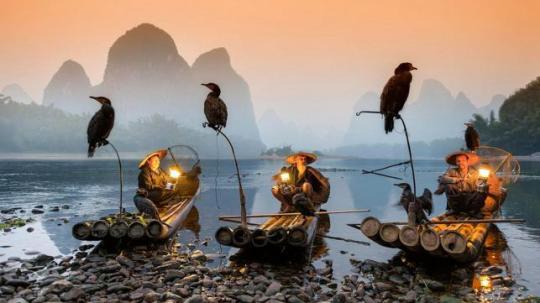




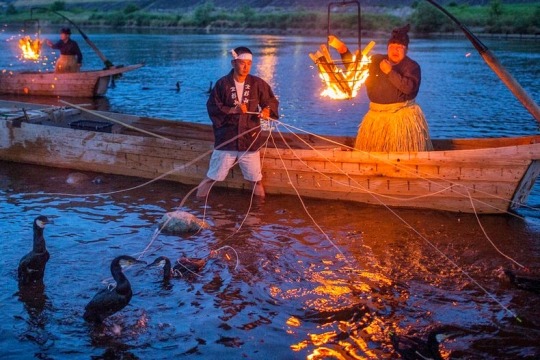


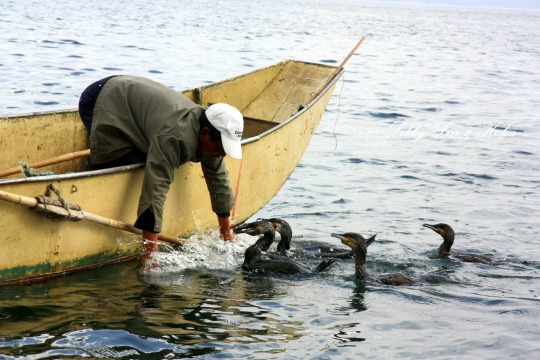
Cormorant fishing is a traditional fishing method in which fishermen use trained cormorants to fish in rivers. Historically, cormorant fishing has taken place in Japan and China, as well as Greece, North Macedonia, and, briefly, England and France. The types of cormorants used differ based on the location. In Gifu, Japan, the Japanese cormorant (P. capillatus) is used; Chinese fishermen often employ great cormorants (P. carbo). Darters (anhinga), which are very close relatives of cormorants, are also used for this fishing technique on occasion.
To control the birds, the fishermen tie a snare near the base of the bird's throat. This prevents the birds from swallowing larger fish, which are held in their throat, but the birds can swallow smaller fish. When a cormorant has caught a fish in its throat, the fisherman brings the bird back to the boat and has the bird spit the fish up. Though cormorant fishing once was a successful industry, its primary use today is to serve the tourism industry.
Cormorant fishing, called ukai in Japanese, takes place in 13 cities in Japan. The most famous location is Gifu, Gifu Prefecture on the Nagara River. Cormorant fishing in Seki also takes place on the Nagara River, but it is called "Oze cormorant fishing". Only the cormorant fishing masters in Gifu and Seki are employed by the emperor and called Imperial Fishermen of the Royal Household Agency.
Cormorant fishing on the Nagara River is a 1,300-year-old tradition where fishing masters use Japanese cormorants to catch fish, primarily ayu (sweetfish). Because of the great skills of the fishing masters, they have received the official title of “Cormorant Fishermen of the Imperial Household Agency,” a hereditary title that is passed on from father to son.
The use of cormorants for fishing on the Nagara River originated as a way for people to feed their families. When cormorant fishing came under the auspices of the Imperial Household Agency, the first fish caught each year were sent to the capital. Because cormorant fishing is part of the Imperial Household, the Nagara River has become a protected river, which keeps it clean and healthy, allowing cormorant fishing to continue through the ages. The birds have become such a part of Japanese lore, that they have given rise to the expression unomi, which means to “swallow whole like a cormorant” or “accept without questions,” because they can swallow fish whole without choking on the scales.
In spite of the industry's decline, cormorant fishing still continues in the city of Gifu today and serves as an important part of the city's tourism sector, drawing people from around Japan and around the world. The first sweetfish of the season are still sent to the capital today and Royal Viewings for members of the Imperial Household are held eight times per year, though viewing is open to the general public on those days as well.
Because cormorant fishing is a daily activity for nearly five months of the year, the fishing masters begin each day by selecting ten to twelve healthy cormorants for the evening's activities. When the birds are selected and the boats are prepared, the six fishing masters draw ropes to determine the order in which they will fish.
When the cormorants catch the fish, they are brought back to the boat using ropes attached to their bodies. When they are back in the boat, the fishing masters remove the fish from the birds’ throats. Each bird can hold up to six fish in its throat. The birds are prevented from swallowing the fish because of a ring tied around their necks. The cormorants, however, are still able to swallow smaller fish. Though the ropes are strong, the fishing masters are able to quickly break them if a bird's rope gets caught beneath rocks, ensuring the bird will not drown.
Each night, cormorant fishing officially begins when three fireworks are set off in the evening sky. At first, the boats come down the river, one by one, catching fish. They use a fire attached to the front of the boat to attract the fish and hit the sides of the boat to keep the birds active. As the night draws to a close, the six boats will line up side-by-side and descend the river in a process called sougarami. Those who come to view cormorant fishing are often able to view the night's catch.
On the boat, in addition to the fishing master, there is also his helper (nakanori, "a rower at the center"), the pilot (tomonori, "a rower at the stern") and, occasionally, a second assistant. These three people work in unison to control the boats and the birds, creating a wonderful harmony on the river. Often, because the position of fishing master is a hereditary position, the helper is the fishing master's son.
In Guilin, Guangxi, cormorant birds are famous for fishing on the shallow Lijiang River. Elsewhere in southern China, the Bai people have utilized cormorant fishing since the 9th century on the banks of Erhai Lake. Traditionally practiced for sustenance, cormorant fishing is now primarily performed for tourists.
Cormorant fishing is an old tradition in Greece and North Macedonia, especially on Doiran Lake which lies in the border of the two countries, and it is still practiced today by some traditional fishermen. In Western Europe, cormorant fishing took place briefly from the 16th to 17th centuries, primarily in England and France. There are claims of some type of records of a form of cormorant fishing taking place in Peru in the 5th century, 100 years earlier than recorded cormorant fishing in Japan.
#cormorant fishing#fishing#cormorant#japanese cormorant#great cormorant#working animals#birds#working birds
2K notes
·
View notes
Text
日本のトリビアまとめ #0017

#Japanese Trivia#Famous places in Gifu#Ijinkan#兵庫の名所#有馬温泉#Hyogo sights#Arima Onsen#姫路城#Hida Takayama#岐阜の名所#異人館#飛騨高山#日本のトリビア#Himeji castle
0 notes
Photo

岐阜城
岐阜の名所
岐阜城(ぎふじょう)は、岐阜県岐阜市にある城で、徳川家康によって築かれた城です。岐阜城は戦国時代の歴史的な重要な拠点の一つとして、名城の一つに数えられています。
1. 家康ゆかりの城
徳川家康が築城した城であり、彼の生涯や活動と深く関連しています。家康はここから出陣し、多くの歴史的な事件を起こしました。
2. 天守閣
岐阜城の中心には、木造の天守閣がありましたが、現在は再建された天守閣が公開されています。展望台からは岐阜市街を一望することができます。
3. 歴史と文化
城内には歴史資料や城郭の構造を学べる展示施設があります。また、城内の広場ではイベントや文化体験が行われることもあります。
4. 周辺環境
城の周りは公園として整備されており、散策やピクニックを楽しむことができます。周囲には歴史的な名所も点在しています。
♪♫♬🎤🎹🎶♪♫♬🎤🎹🎶♪♫♬🎤🎹🎶♪♫♬🎤🎹🎶
Gifu Castle
Famous places in Gifu
Gifu Castle is a castle located in Gifu City, Gifu Prefecture, and was built by Tokugawa Ieyasu. Gifu Castle is one of the historically important bases of the Sengoku period and is considered one of the famous castles.
1. Castle associated with Ieyasu
This castle was built by Tokugawa Ieyasu and is deeply connected to his life and activities. Ieyasu set out from here and caused many historical incidents.
2. Donjon
There used to be a wooden castle tower in the center of Gifu Castle, but now the reconstructed castle tower is open to the public. You can see a panoramic view of Gifu city from the observation deck.
3. History and Culture
Inside the castle, there are exhibition facilities where you can learn about historical materials and the structure of the castle. Additionally, events and cultural experiences are sometimes held in the square within the castle.
4. Surrounding environment
The area around the castle is maintained as a park where you can enjoy a walk or a picnic. There are also historical sites scattered around.
0 notes
Text
Cultural References in “They Are Out There Saying”
It took me forever to compile it, but here it is! A brief explanation on all the references to Japanese culture I made in my JayDick Summer Exchange fic “They Are Out There Saying”.
https://archiveofourown.org/works/25707886/chapters/62420596
When I got the prompt from @paperempires calling for the Batman Ninja verse, I was like, you want 16th century Japan? I SHALL DELIVER.
Ok, so first, let’s talk about geography.
Right now, Japan is divided into prefectures, but in the past there were provinces. Check out the map below.
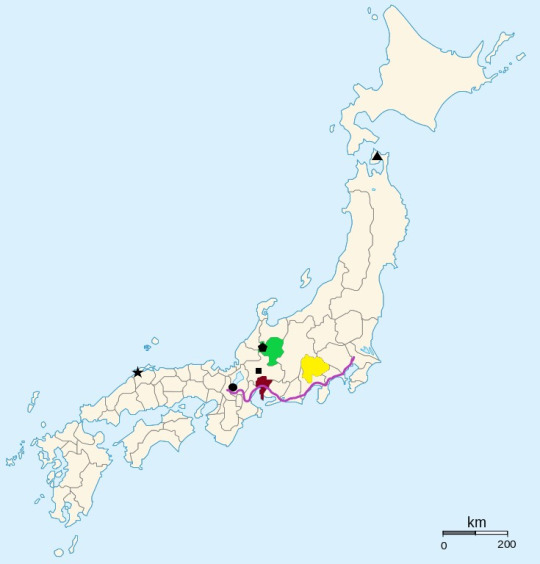
Green: Hida Province
Aka the province where this fanfic actually takes place. Nowadays the Hida-Takayama region in Gifu Prefecture.
Located there is the hidden village of the Bat Clan, the calligrapher's house, as well as real places briefly mentioned: Takayama city with its castle (ruins) and Tenshōji Temple (associated with True Pure Land school of Buddhism), and Shirakawa Village (diamond shape on the map).
Btw, Shirakawa Village is a UNESCO world heritage site and overall a lovely place. If you have a chance to visit it, please do. Here, check it out 😊.
Also, Hida is one of the two places in all of Japan where gneiss, a type of metamorphic rock, can be found. A piece of trivia I learned from my best friend (who might or might have not dared me to fit gneiss somewhere in the fanfic) 😉. The second place where gneiss can be found - again, true fact - are Oki Islands, the archipelago north of the Grand Izumo Shrine.
Dark red: Owari Province
Nowadays part of Aichi Prefecture.
According to the Batman Ninja (the version with Japanese voice over) Joker made himself a feudal lord of this province. Which is kinda interesting, seeing as Oda Nobunaga (1534-1582), one of the key players during the warring states period who started the unification of Japan, was a lord of that domain.
Located in Owari is also Alfred's teahouse 😊.
Yellow: Kai Province
Nowadays, it's Yamanashi Prefecture.
Penguin made himself a feudal lord of this domain. In Batman Ninja he really commanded penguins wearing samurai armour 😂.
Violet line: Tōkaidō Road
A tract that linked Kyoto, a seat of the emperor, and Edo (present day Tokyo), the seat of shogun.
So, traveling the Tōkaidō Road didn't become a thing until the 17th century ^^". But I figured, if castles can be weaponized in this verse, then I can send Jason down this road 😊.
On the side note, travelling the Tōkaidō Road became quite a subject in the culture of the Edo Period (1600-1868). For example, check out these famous ukiyo-e.
Star: the Grand Shrine of Izumo
Very much a real place. One of the three most important Shintō shrines in all of Japan. Worshipped there is Okuninushi no Okami, god of marriage. When praying in the Grand Shrine, a pilgrim is supposed to clap their hands four times, not just two like everywhere else. That's because in that Shrine one is not praying just for themselves, but for their destined partner too.
The Grand Shrine is located in the Izumo Province - nowadays a part of Shimane Prefecture.
*Even today Izumo is called a place where fates are being brought together 😉.
Circle: Mt Hiei
Again, a real place, located very close to Kyoto. The Enryakuji temple located on that mountain historically had big influence also due to the fact, it commanded its own army of warrior monks. Some further reading on them, if your interested, is here.
(Btw, the Enryakuji Temple is also a UNESCO world heritage site.)
It was emperor Shirakawa (1053-1129) who one said that the only things he does not have control over are the roll of dice, the waters in Kamo River and the warrior monks of the Enryakuji Temple.
*Kamo River flows through Kyoto.
Square: Inabayama Castle
Nowadays called Gifu Castle, located in Gifu City, Gifu Prefecture 😊. One of few castles built on top of a mountain.
Triangle: Mt Osore
A real place, considered one of the most sacred in all of Japan. A site of Bodaiji Temple. Due to the volcanic activity in the area, there's sulfur both in the air and in the lake right by the temple - hence its striking colour. Otherwise, the landscape is barren.
It is said that Mt Osore matches the description of Buddhist hell, and holds the entrance to the afterlife. For some further, light reading check here.
If you think to yourself wooow that's a lot of references then fear not - there's more 😂.
Other references
Fuke Sect of Buddhism
Monks of this sect, as a part of their practise, wore basket hats, played flute, and were on constant pilgrimage.
Travel, however, used to be heavily restricted, so in exchange for a special travel permit, monks were asked to spy for the shogun. Also, ninja (and other people involved in espionage) were known to donn on the attire of a Fuke Sect monk. For that reason, monks were sometimes asked to play on their flutes to prove their identity.
In Batman Ninja Jason is operating undercover as one of those monks.
Check this, for some further reading.
Direction of the Demon’s Gate
It’s north-west. It was believed that demons and evil spirits enter through that direction, hence it was considered unlucky.
Rokuyō (lucky/unlucky days)
A circle of six days, three of which are thought to various degrees lucky, another three - to various degrees unlucky. The most unlucky one is called butsumetsu and apparently is meant to symbolise the day Budda died.
Ri
Old unit of measurement. 1 ri ≈ 3.9 km ≈ 2.4 mi
Sexagenary cycle
A cycle of 60 years. It was traditionally used in China for time reckoning, and was known in other South-East Asian countries too.
For some further reading click here.
Golden leaf
Kaga Province (north-east of Hida; now part of Ishikawa Prefecture) is known as the biggest producer of golden leaf in all of Japan.
Zen Circle
On the photo below:
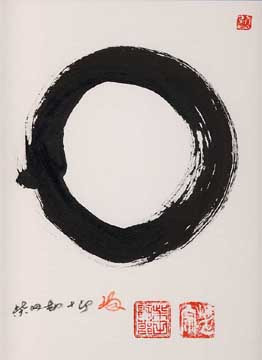
It’s an important symbol in Zen Buddhism that stands for enlightenment, absolute, the void. In Japanese calligraphy and sumi-e (ink painting), drawing the circle is seen as an expression of absolute freedom of the mind that lets the body create. If it’s closed, it symbolises perfection. If not, it becomes an expression of wabi-sabi - a concept in Japanese aesthetics that translates to beauty of imperfection.
Kappa
One of the fantastic creatures that appears in many Japanese folktales. Kappa is a water demon that (unsurprisingly) dwells in lakes and rivers. It is rather mean and known to cause mischief, but surprisingly enough - very fond of cucumbers.
Ogre (oni)
One of the fantastic creatures featured in Japanese folklore. Usually portrayed with red skin, horns, and a tall, hulking figure; as a concept somewhat similar to demons or devils, as they represent everything evil and harmful (and also, oni reside in the eight great hells). It was believed a human wicked beyond any redemption might turn into an ogre.
Haikai-no renga
A genre of linked verse poetry. It is made of 18 or 36 verses that alternatively have 17 (5-7-5) or 14 (7-7) syllables. It is less formal than an earlier genre, renga, and as such is supposed to be lighter, witty, comical even. There aren't as many rules dictating which verse is supposed to have a direct allusion to which, how many times and in which verses certain motives (like flowers, moon, seasons) can be mentioned.
Still, the first verse is supposed to contain kigo, so a word or phrase that indicates the season - in the fanfic it’s May (rice planting season) which is classified as early summer in the old lunar calendar - or in some other clever way gives an allusion to the environment the poetry meeting took place in. The first verse is also supposed to be written by the guest of honour which is why Jason was asked to compose it 😊. Important is also the third verse, as that’s where the theme of the whole haikai-no renga is officially established.
From the first verse of haikai-no renga evolved possibly the most recognisable form of Japanese poetry - haiku.
Lovers’ suicide
A suicide committed together at the same time by the lovers whose shared affection defied the rules of society and/or obligations to their families. Before commiting the act, they would usually pray to be reborn together on the same lotus flower in the Pure Land.
Lovers’ suicide is a theme featured in plays for pupper theater bunraku, most prominently The Love Suicides at Sonezaki written by Chikamatsu Monzaemon.
Pure Land
In a nutshell: According to some schools of Buddhism in Japan, Pure Land where people can be reborn and practice pure version of Buddhism, thus are able to finally gain enlightenment (which is impossible when alive, because the practice in the land of the living is warped, impure).
Please, take my way too short explanation with a grain of salt. It might not seem that way, but I’m not all that knowledgeable about Buddhism ^^”.
Nenbutsu prayer
Practised in True Pure Land Buddhism. It’s basically a recitation of a short phrase that translates to “I take refuge in Buddha Amida”.
Kannon
The bodhisattva associated with compassion.
Vengeful ghost
It was believed that a person who harboured a deep grudge or hatred in their last living moments towards those who had wronged them could become a vengeful spirit.
*Hoichi the Earless - one of the traditional horror stories. In this story, vengeful ghosts (of the fallen Taira clan) want to take with them a blind monk because he beautifully plays on biwa (traditional instrument). Once his brethren realise the danger Hoichi is in, they paint his whole body in Buddhist sutra, safe for his ears. Because of that, when the ghosts appear again, Hoichi - safe for his ears - is invisible to them. Spoiler alert, the ghosts take Hoichi’s ears, thus the earless in the title. Check out here for some further reading.
Ten Virtues of Tea
Text attributed to a Buddhist monk Myōe (1173-1232. It lists all the properties of green tea beneficial to the human body and soul.
Translation can be found here.
Portuguese firearms
Historically, the first Europeans Japanese people came in contact with were Potuguese traders. They introduced many European goods including firearms.
On the unrelated note, the Potuguese in that time period were referred to as Nanbanjin (南蛮人) which translates to southern barbarians.
Eight great hells
...are the concept of hell in the traditional culture in a nutshell. The concept itself was heavily influenced by Buddhism.
Further reading is available here.
Shinto wedding ceremony
While it incorporates many rites, the most core one (as far as I know) features the groom and the bride taking turns drinking sake (rice wine) from three cup, each slightly bigger than the other. When drinking, they are supposed to sip three times.
In feudal times, wedding ceremonies started with an elaborate bridal procession to the groom’s house. There, the dowry would be presented, blessings would be given, and then the bride and groom would take turns drinking sake as described above.
...Okay, I believe that’s it. Thank you for reading!
#jaydick summer exchange#fanfic notes#jaydick#japanese culture#references explained#i am such a nerd
31 notes
·
View notes
Text
yall i REALLY thought i was on to something about joker’s hometown bc in the cutscene where he’s in shibuya for the first time the camera shows a close up of his navigation app
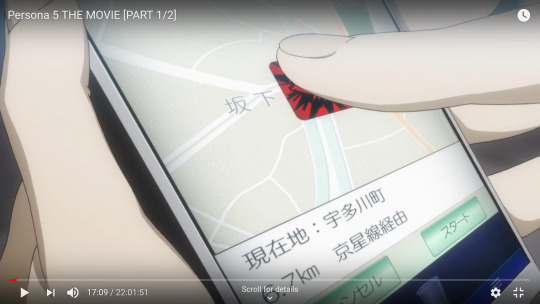
i didnt know enough kanji to read all of it, but i thought the first line might of been where he started (aka his hometown) and i was like, “ooh, 宇多川町ーUtagawa Town?! Where’s that?” and i tried to look it up but all i got was 宇田川町ーor Udagawa which is literally Shibuya....so atlus punned me...also when i actually translate all the kanji, the top line says Current Location and the bottom line was the train route he was using (i think). The train line is called “Kyousei” which is the same train you can hear about in game (im pretty sure).
okay OKAY but the next interesting thing here is (tho take this w a grain of salt bc i dont use navigation apps enough to know for sure) but the next important thing are the words underneath joker’s finger

so the kanji on the left 坂下 says “Sakashita” as the most common reading and the kanji on the right 駅前says “before station” so like ‘right before the train station’. This train station at Sakashita seems to be joker’s starting point to his current location MAYBE. MAYBE.
so i was like “Fuck i need to look this up what i this is where he came from?” so i do that and gogle tells me this
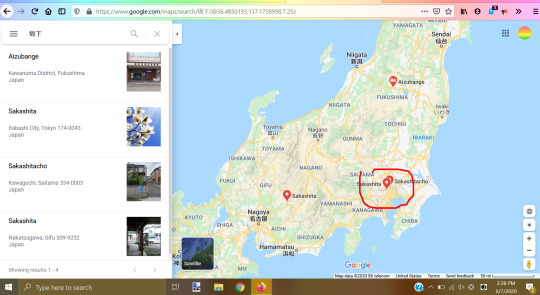
god i hope you can see this. ANYWAY is get 4 places on the maps with 坂下 in it: A store(?) in Fukushima, 2 different town areas in the tokyo area (marked in red circle on the map), and the town Sakashita in Gifu Prefecture. so. So. im like holy shit okay here we go
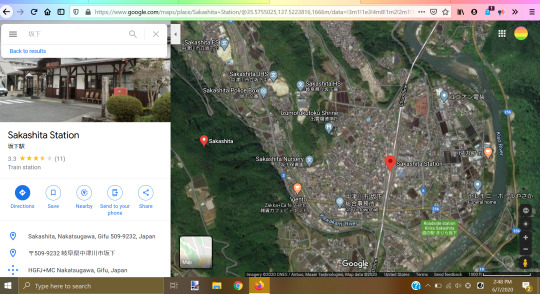
heres a satellite view of Sakashita in Gifu. its green and mountainous, its got two rivers surrounding it (one of which is named Kawakami pfft, probably unintentional), has like 1 set of schools named after the town, normal government & community spaces, a few shrines, and a train station for the Chuo line which goes to Tokyo(eventually)! id say its remote enough that the PT calling him a country bumpkin is granted. the town has buses and everything for the long roads, but i imagine a lotta students and workers walk/bike to work.
i like that Sakashita is south of Tokyo bc i like holding on to the fact that joker speaks the kansai dialect (most often associated with characters that are Different, but comes from a real place yknow) and kansai is south Tokyo. Now Gifu region is not in the kansai region but its close enough yeah? like maybe his parents came from closer to Osaka or Kyoto or some shit yeah?
i even made sure the roads near the Sakashita station kinda fit the map on Joker’s phone. i thought, “oh, its like a simplified version,” but then i focused on the (6.7 km) part and i was like hmmmmm.....
.....so i rewatched the cutscene to see if i could see more and i am :(((
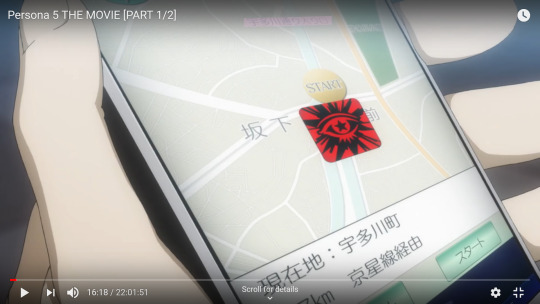
this is earlier in the cutscene where you can see more of his screen. the part i have highlighted in pink at the top is the same Utagawa pun from the beginning of this

heres the map in gogle of Shibuya Crossing area. The red line is the subway ans the green is a road named 宮益坂下 or Miyamasu-zakashita which uses the exact same kanji. basically joker was just walking from somewhere to the station, and the 坂下 (sakashita) that i saw that was close to a station and the Kyousei line was just referencing the main road that all the vehicles uses with the large crosswalks that Shibuya Crossing is famous for...so i was wrong But BUT!! that doesnt mean Sakashita in Gifu prefecture is not valid (at least for me). I normally like to headcanon the Idiots in Inaba AU because it makes my heart warm for all the connections that are possible, but sometimes i like to use a different setting just because. and i want that location to be as close to real life as possible bc i love maps so much and hhggg im just like this
now that im done info dumping plz enjoy
#p5#persona 5#ren amamiya#akira kurusu#this is not the first time ive tried to do something like this for jokers hometown#joker lovin hours folks#boop.txt
42 notes
·
View notes
Photo
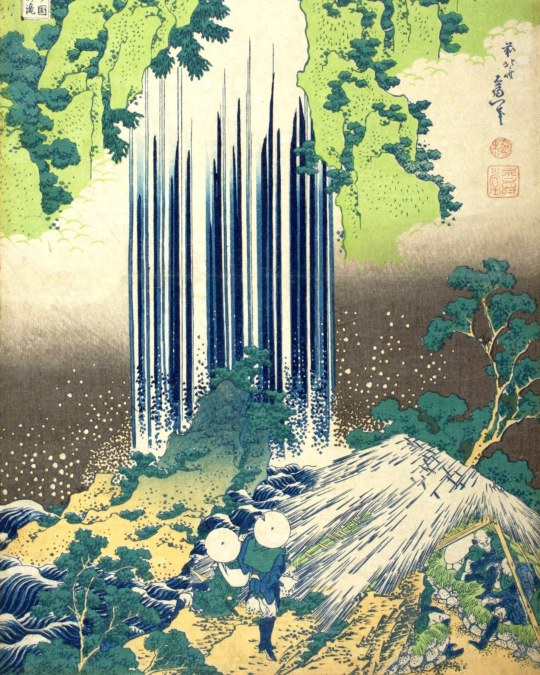
This waterfall in the town of Yōrō (Gifu prefecture today) was renowned as a source of miracles. Its healing waters are referenced in a legend about the filial piety of a son who sought the healing properties of the water to help his ailing father. The boy managed to take some water back with him, and upon returning home it had transformed into sake. After drinking the miraculous draft, his father was revivified.The real falls are some 100ft tall, but here Hokusai has chosen to deliberately diminish their height to avoid the necessity of making the human figures tiny by comparison. It is not known whether Hokusai actually visited the location himself. The waterfall was illustrated in the gazetteer "Famous Places on the Kiso Highway in 1805, allowing us to identify the small building in the bottom right as a simple guest house for weary travellers.
6 notes
·
View notes
Text
Koito Otonoshin is from Kagoshima; what does the city and area reveal about his character.
While on holiday, I was very lucky to have a chance to visit Koito’s very own hometown of Kagoshima, in Kagoshima Prefecture on the southwestern part of Kyushu. I’ve grown more attached to Koito’s character as the manga has developed and I’m more curious to try to figure out what he will do in the manga now that he has been “reunited” with Tsurumi. So, I figured why not go visit his hometown in January when the weather will be lovely [it was]. I will admit that I tricked my Mom to go with me not knowing it was a Koito research trip, but at least told my brother. He was fine with it since he had wanted to visit the nearby Miyazaki prefecture anyways.
This will be a little bit of a different meta post as I’ll present things I observed and try to place Koito in the context of them. This is based on my opinion and how I interpreted and observed things around me. Please keep that in mind when reading!

To get to Kagoshima, I took full advantage of the JR Rail pass for tourists and left from Kyoto to Kagoshima-chuo, the main train station with a transfer at Shin-Kobe. I went down in early January and it was lovely to see the scenery become more green as I went further south. Kyushu has a different feel than the island of Honshu, you see subtropical and tropical plants and it really feels different than other parts of Japan that I have visited e.g. Tokyo, Kyoto and Osaka. This was my first time visiting Kyushu and I really loved the southern part of the island.
If you are using a rail pass to get there, it will take you some time, it was about 5 hours or so in total from Kyoto. If you go from Tokyo, it will take at least 7 hours and that is just from Kagoshima-chuo to Shinagawa (Tokyo area) station. If you are unable to use a JR pass, like my brother who is currently working in Japan, or you have very limited time, the best option is to fly, say from Tokyo-Haneda to the Kagoshima airport (40 min bus ride from downtown Kagoshima).

The most obvious thing about Kagoshima and the area, is how different it is than parts of Honshu. The entire area has that tropical/subtropical feel. It was January and the weather was quite pleasant, around 14-16 degrees C as the high during the day and lows around 7 or so. It was sunny and there were flowers blooming everywhere in gardens and parks and you are right next to the bay! It was so lovely.
I have somewhat limited travel experience in Japan only able to previously visit cities like Nagoya (for work), Gifu (for work but Oda Nobunaga!), Kyoto, Nara, Osaka, Hiroshima, Tokyo and Shizuoka (for maguro tuna) before this trip. What I can say from the start is the feel and look of Kagoshima is different than these other cities. There are more colorful buildings in Kagoshima, some were green, lime green, light pink, magenta and orange intermixed with the more standard, black, grey, white of the modern Japanese landscape. The urban landscape was more varied and interesting than other cities I’ve been to in Japan.
There were many older western style buildings and street lights / lamp posts that looked like they were from 1880-1930. For example here is a public building that clearly looks like it is from 1900-1930 or so. I tried to figure out what it was, but it simply said civic building and likely was now associated with the performing arts center right next to it from about the 1950s/1960s. You can see lots of cycads(!) planted out in front of the building.

The city still runs streetcars that have old lamps as a part of the posts that hold up their electrical cables. I forgot to take a picture of some of the streetcars; half of their cars were old, ~1940s-1950s at the newest as well as sleek modern streetcars. I snapped this photo of the streetcar operator while riding in the city. Yes, it is an old lever operated drive system! It appeared to be made by Mitsubishi, and you can see the flowers blooming in the background.

A great example of a more western style building was this large department store in the downtown part of the city. It is the Yamakataya Department store, and after some quick online searching it appears to have been built around 1917 with other parts added on over time. You can find more photos of it on TripAdvisor.
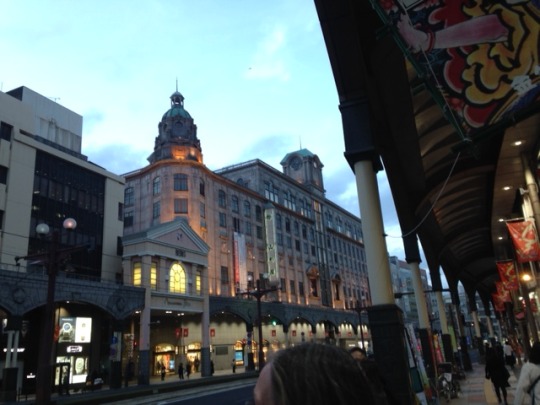
I spotted other older Victorian and turn of the century buildings in the city which added to the unique vibe of the city. While wondering around the local shopping arcades looking for a restaurant, we stumbled upon an interesting glass ceiling at one of the intersection of the arcades. Four locations are shown on the map, Kagoshima, Malacca (Malaysia), Goa (India) and Basque (Spain).
This one shows Kagoshima and Malacca, with ships, churches and random people meeting missionaries, specifically Jesuit missionaries including Francis Xavier, who visited and converted people to Christianity in Kagoshima in 1550.
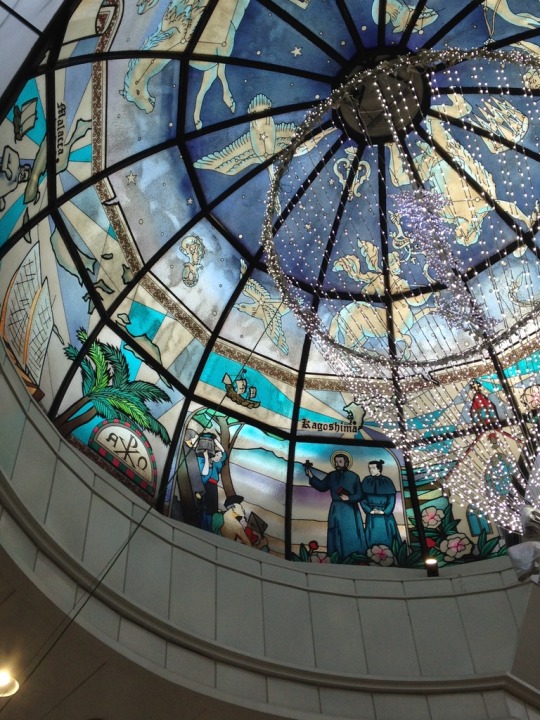
The Basque region of Spain, where Francis Xavier is originally from, though he worked throughout Asia. He was a pretty successful missionary all things considered.

It highlights his time as a missionary in Goa, India
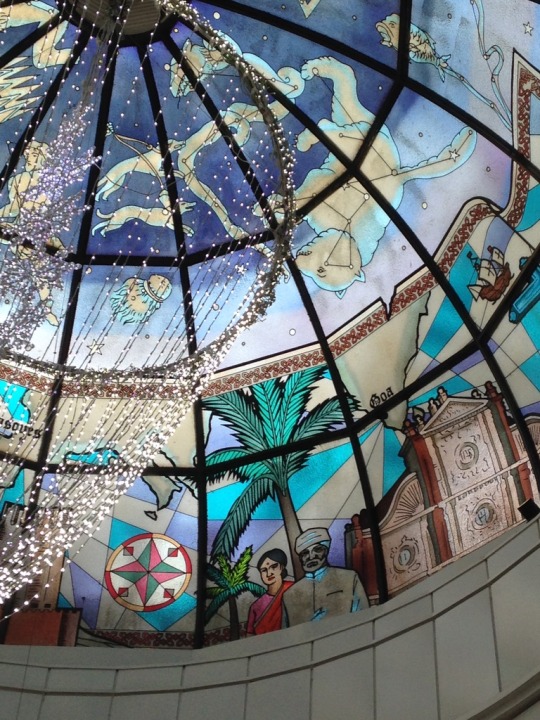
And of course in Kyushu, including Nagasaki and other places as well as Kagoshima. I find it quite curious they have the classic Greek constellations on the sky and not the Japanese ones. It is quite clear that the Jesuit missionaries had an important influence on many people in Kyushu and they still have the highest number of Christians in Japan. I would guess that local people commissioned this artwork since it clearly celebrates the life of Francis Xavier and connects Kagoshima to the other places he lived and worked.
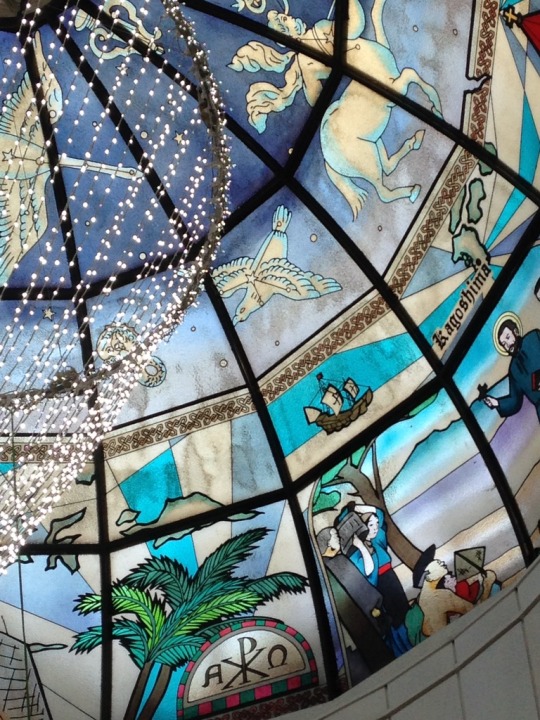
Kagoshima is uniquely situated as how far south it is from both Kyoto and Tokyo [Edo]. By road it is between 800-900 km to Kyoto and 1,300-1,400 km from Tokyo. This implies that it would take a long time before modern technologies in transportation to go between the places of power pre-Edo period and during the Edo period.
I was able to visit Sengan-en an estate of the Shimazu family. The Shimazu family held power in the region since around 1300 and were both powerful warlords, but also successful in international trade due to their location on Kinko Bay. As the Shimazu family were still under the power of the Tokugawa shogunate they were required to journey to Edo, but as a result of the distance, they had the longest overall travel time out of everyone in Japan. I’m sure you can quickly realize that having such a distance from the central government also resulted in the Satsuma domain having more freedom than say a powerful samurai family in Shizuoka.
Even when the Tokugawa shogunate closed off most of the country, this region was still able to trade internationally by proxy through the Ryukyu Islands (Okinawa) and developed more international style cuisine as a result. Sweet potatoes were introduced via Okinawa and the Satsuma sweet potatoes are everywhere. I bought and tried some dried-ish sweet potatoes that looked like twizzlers, but were underwhelming (I think this was a tourist trap, oh look sweet potato things, I’ll try them!). At Sengan-en, we ate some of the baked sweet potatoes of the local variety which were incredibly delicious as just plain potatoes. I’ve had baked sweet potatoes elsewhere in Japan and outside, but this was the best plain baked sweet potato I have every had! I also got sweet potato candy which is delicious, a variant of the famous Bontan Ame (a citrus caramel candy), also invented in Kagoshima! Bontan Ame is also a great candy, I love the subtle citrus flavor.
The sweet potato are the purple caramels on the right and the citrus Bontan Ame on the left. quantivore’s Koito is excited with Tsukishima in between! (quantivore’s artwork can be found on instagram @quantivore ).

Bontan Ame are popular with high school girls . . . for some odd reason I think that Koito would like them too!
I was able to sample some local Kagoshima shouchu, which again, is not surprisingly made from their famous Satsuma sweet potatoes! It tasted good and was pretty strong. I may have had more to drink than I should have with my yakiniku. There were soooo many varieties of shouchu to choose from in the area and they were sold at pretty much every gift shop! I did not buy a bottle since I was afraid to haul it all around Japan and break it on accident.

Recall that the manga highlighted that the Sakurajima daikon are cultivated in the area around the Sakurajima volcano and are the largest daikon in the world as introduced in chapter 197.
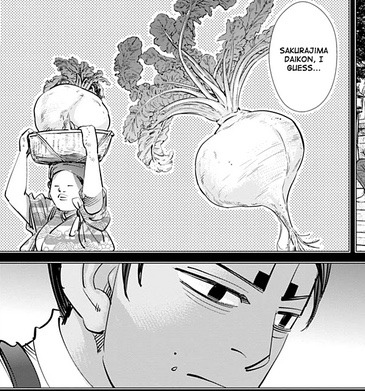
I was unable to see a full daikon in the flesh, while visiting the Sakurajima Geo-Park, I did spot some growing in the ground and you could see large leaves! I really wanted to see a Sakurajima daikon, in person. The daikon was found on public city artwork and designs. I had to settle with only seeing their leafy tops while on a bus, though I bought a small daikon charm and my brother found me a plushie at the airport. I did eat some daikon (already cut to a much smaller size) with the regional black pork which was delicious. The pork was richer than normal ground pork and the daikon melted in your mouth as you ate it cutting through the richness of the pork.
The daikon is important to Koito’s flashback as it helps to introduce his contrast to his older brother, who had a pale complexion like a Sakurajima daikon and tolerated Koito calling him that.
The last major regional produce of the area is citrus! There is so much citrus in the area! The Satsuma oranges (as they are known in the UK) came from the Kagoshima region after they went to war with the British in 1863! As a result of a naval battle between the Shimazu family and their fellow Satsuma retainers, this war only lasted a few days and resulted in great damage to the Kagoshima area. The positive outcome of this was increased positive relations between the Satsuma region and the UK as opposed to the influence the French government had on the dying/declining Tokugawa shogunate in Edo.
Here is a Satsuma orange tree at Sengan-en. It had an info plaque about how after the Anglo-Satsuma war they were popular for import to England.
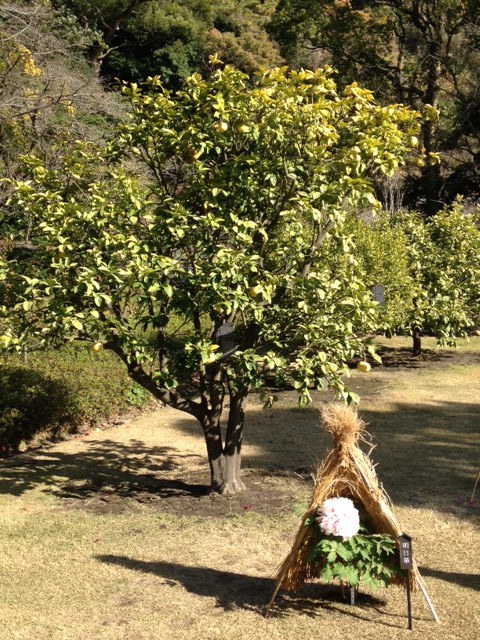
In addition to the Satsuma oranges (aka mikan), there is a distinct variety from the area known as komikan or small mikan. These are grown both on the volcano, Sakurajima (桜島小みかん) and around the Kinko Bay as well (小みかん).
Look at the tiny tiny tiny komikan!
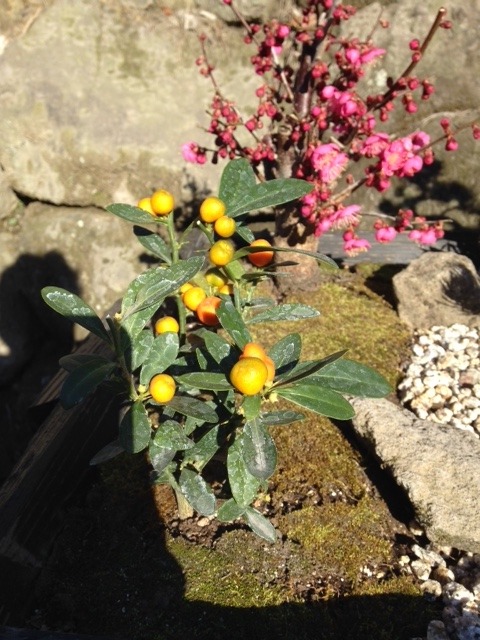
The regular mikan were quite easy to peel and delicious. Throughout the southern part of Kyushu there were lots of different citrus species and cultivars grown. In the neighboring Miyazaki prefecture, they had a yuzu x pomelo hybrid known as a hyuganatsu (also tasty in things!). I digress, the point is Kagoshima as the former Satsuma domain is a place that was able to interact with western nations and it is in part represented by the movement of the citrus fruits from the area to places like the UK and the USA as well where the States actually imported and grew cultivars from the Kagoshima area.
This region was also much more forward thinking that the government in Edo. The Shimazu family were the second largest book publishers in Japan for a very long time and they reprinted Western imported books that included science, technology and maps. I was able to see some of their moveable type for their publishing with both Japanese kanji and kana and the Latin alphabet as well for printing foreign books (I did not spot any Cyrillic, but the museum display was small).
They were the birth of industrial manufacturing in Japan, first trying to build equipment via imported books and later sent students abroad against the rule of the government to study in the UK and the USA. At the grounds of Sengan-en you can visit the first factory in Japan which gives a quick guide in Japanese and English about the development of industrial manufacturing. Unfortunately, you were unable to take pictures in the museum, but they produced various goods including cannons and whatnot which helped in late Bakumatsu period and gave them a weapons advantage over the outdated technology of the Shogunate government forces.
When you get off the train at the main Kagoshima-chuo station and walk towards the bus and streetcar stops, there is a statue erected in honor of all of the young students who risked going abroad to help the growth and development of Kagoshima.
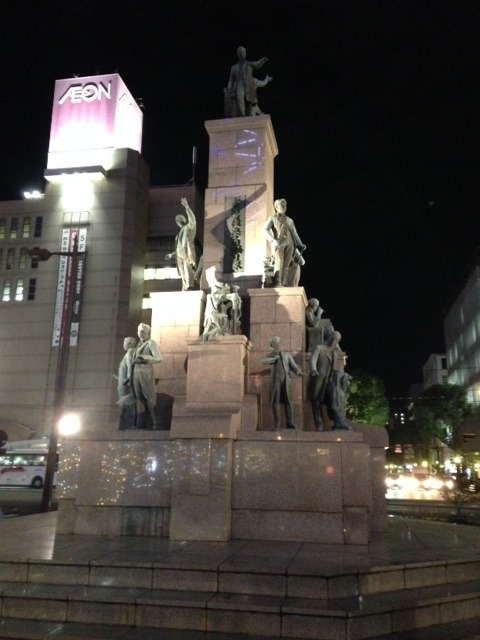
These students also attended a World Fair in Paris or some of them not quite sure if all of them attended it was after their trips abroad. They also circumvented the travel restriction for Japanese by registering not as from Japan but representing the Satsuma domain as an independent delegation. I may not be 100% accurate with all of this info, since I couldn’t take photos in the museums, yet it gives you a good idea of what the Satsuma domain was doing to improve and modernize.
There is also a strong connection between Satsuma and Hokkaido - many of the leaders during the Meiji era that pushed industrialization were from Satsuma and used Hokkaido as the source for raw materials to power the factories in the south. Plus, many people from the region moved to Hokkaido to work either as the frontier soldiers or as laborers in the “frontier”. This has been mentioned before in regards to GK as Noda’s own great-grandfather was a frontier soldier from Kyushu (whom I’ve wondered was also a practicing Catholic based on how Noda depicts Christian theology). I recall reading this in some interviews with him translated by GK Central, but I forget which ones right now.
Another industry that grew up in the mid 1800s was the development of Satsuma cut glass (kiriko) which become more industrialized during the late Edo early Meiji period. Unfortunately, the technology was lost and in the 1980s, it was finally determined how to manufacture it again. As a result production started again and it is only produced in Kagoshima.
On the grounds of Sengan-en they have a fully operational glass works. You can watch the glass being blown, shaped, cooled, marked and cut. It was pretty neat! I thought about buying some; it was more expensive than I expected - small pieces started at about $200 USD and it only went up from there. There were gorgeous sets of two glass that sold for about $500 and it was clear they were wedding presents. It was really amazing and if I had more money, I’d be tempted to purchase some myself. My Mom did purchase a small green and blue bowl after looking at it at the glass works, and then looking at it in a Satsuma local goods store two more times before deciding to actually purchase it.
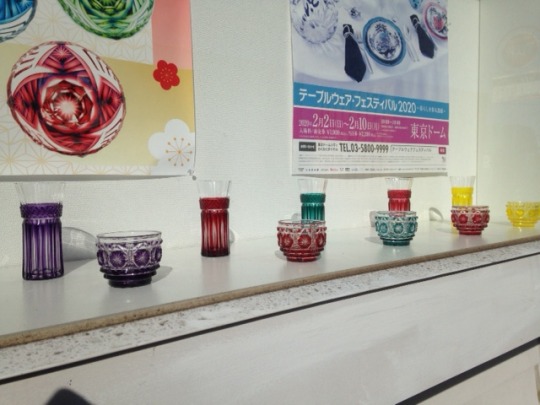
Since it was unique, the distribution of this from Satsuma helped with international relations and was considered neat by those in Europe who could purchase it. I think the best way to look at the cut glass is that it was an excellent example of a Satsuma [Japanese] product that combined with a European product, illustrating how this region was changing to adapt to modern times outside of Japan. There was also Satsuma porcelain that was made for the European market and it was very successful around the time of Golden Kamuy as an export.
To get an idea of the type of house that Koito likely grew up in, it would be something similar to, but obviously smaller than a place like Sengan-en. The house was quite large and the gardens and other buildings around it made for a place that was large and significant looking. It also had a mix of a Japanese and more Western style for some of the buildings as well as Chinese and Ryukyu influence.
This is the main gate that leads into the area where the house is in a large courtyard. It has a much more Chinese style with the bright red and slightly different roof shape. The English info said it was Chinese style, but I wonder if it wasn’t more Ryukyu since they were the domain that was essentially “controlling” *ahem* them at the time.

This was the inner courtyard of the house. The house had been added onto over time from the 19th into the 20th century as well as some parts being removed like household secretary rooms and other stuff now outdated.
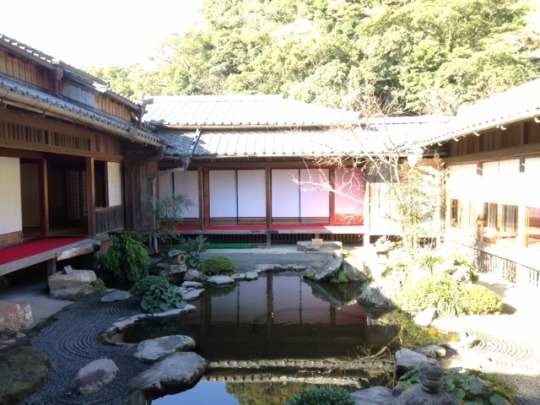
The Shimazu family often hosted foreign dignitaries including Tsar Nicholas II (obviously before the Russo-Japanese war)!!! There were two large vases that were gifted to the family from Nicholas II on display in one of the rooms with lots of historical information about how the family hosted many people from around the world. Many of the people hosted here were from the UK and the Netherlands as well. If I recall correctly, the highest number of foreigners were from the UK (again, that Sastuma orange link).
This is an example of how the table would have been set for dinners for hosting European guests. The vast majority of the house was still completely Japanese in style in regards to the furniture, but this dining room and another (sitting? living) room had Western style furniture. The table setting appears to have Dutch plates, Western cutlery and several types of glasses including the local Satsuma cut glass produced in the local glass works. I believe my Dutch Canadian friend has the exact same plates that you can still buy today.

I took tons of photos of the grounds which featured many tropical and subtropical plants like these cycads and palm tree. You can see some of the buildings in the background and a Western style lamp post as well.

I have no idea what this building originally was, but it was clearly based on a European inspired design and a part of the estate. It is now a Starbucks and I didn’t investigate it any further.

The style of this house makes me think of the house that Koito lived in when his family moved from Kagoshima to Hakodate. There was also a “foreign engineer” house close by where English engineers lived and helped with the development of Kagoshima. I was a moron and forgot to visit it . . . but I did see it from the road.
https://whc.unesco.org/en/documents/136169
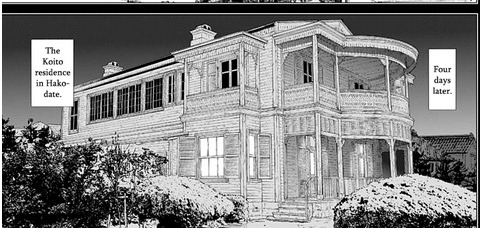
I would say it is a toss up if Koito lived in a modern Japanese style house/estate like Sengan-en in Kagoshima or in a more modern house like the white one on the Sengan-en estate or the “Hakodate” house above.
What you get from visiting a place like Sengan-en is what it would have been like to be an elite from the former Satsuma Domain/Kagoshima. Including your personal doctor inspecting your poo everyday . . . These [predominately] men in power were hosting and having dinners with foreigners and were very passionate about the modernization of Japan in the face of the world colonial powers getting closer to them.
This connects with the fact that Koito owns the motorbike. Now it is unclear if this came from a Japanese individual in France or directly from a French person. When I did my chapter meta, I assumed it came directly from a French person but upon reading it again, the translation is unclear what the nationality of the acquaintance is, just a person in France not actually French. What it does show is that Koito’s father is connected internationally as a member of the Meiji elite many of whom came from Satsuma due to their pro-Western technology slant so that the could expel the barbarians [and freely make use of their science and technology for Japan]. I would guess the fact that Koito Sr. served the Meiji government well, indicated he was more in favor of modernization and less about a more hyper samurai opinion to maintain the old ways during modernization (e.g. Saigo Takamori).
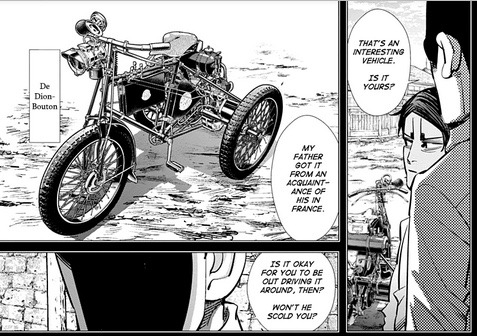
Another thing is how the men in power from places like Satsuma linked themselves to the former shogunate through marriage and likely married women from the “losing” side to further integrate themselves into the power base in Tokyo. You wouldn’t want to completely cut out the losing side completely. Instead, with those that likely switched sides sooner integrate with them as you had the “in” to the old government which would become key for the new government fit into for stability. Completely cutting off members of the former government would lead to future issues since many of those individuals were still clearly wealthy and had more local connections in Tokyo than someone from Kyushu may have had.
Recall, when Hijikata fights Inodou, he mentions Enomoto Takeaki in chapter 135 as noted by EHS scans. He was a member of the Shogunate government who was key in founding the Imperial Navy that Koito’s father is a member of.
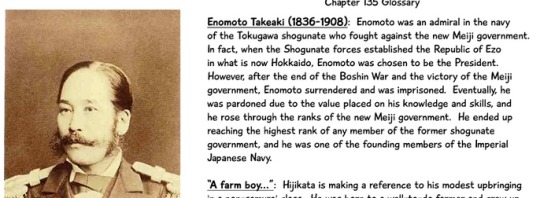
Another thing I learned at Sengan-en is that one of the Shimazu daughters married the last shogun in part to politically sway the shogun to transition and make way for the new Meiji government. This again shows that those from places in the south were positioning individuals to allow them to create a new government as easily as possible.
Since Koito’s father is a tall, darker complexion Satsuma man, as Koito is, his flashback highlights how different his mother looks. She’s very light in complexion and Koito mentions on his older brother looked like a Sakurajima daikon with very light skin tone.
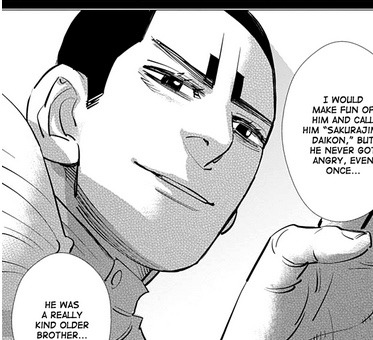
Koito and his brother got their eye brows from their mother, yet he did not get her lighter skin tone, so on top of his Satsuma accent, other characters can tell that he’s from Kagoshima (or at least someplace in Kyushu).

I find it interesting that Koito’s mother is wearing a kimono in a house that is completely Western in decor and she almost looks uncomfortable in her surroundings. I can’t help but think it would be more socially appropriate for Koito’s mother Yuki, to also adopt Western style dress to fit with her position and role as the wife of an important member of the military and modern society. It is clear they are hosting foreigners in some fashion. When I was visiting Sengan-en, there were many photos of women wearing Western style dress ~1900, so many of them also adopted their fashion like their male family and friends did. Yet, instead, she seems out of place as though she didn’t grow up with this style (somewhere around Tokyo perhaps) and is unsure how to fit within it. Koito in contrast since his introduction at 14, is shown wearing full Western style dress and he’s sporting a much more Western style hairstyle than any other character had as a kid. Does he have an English style haircut?
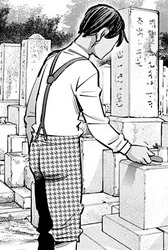
I always get the feeling that Koito being raised in a more Western learning environment as a child in Kagoshima and being surrounded by a greater mix of people and seeing more differences he is just more comfortable in his role as a future military kid. He may not even realize it, but compared to many of the other GK cast members he’s both sheltered and open to things with his education. He has been spoiled and it shows in his dependence on Tsukishima, yet at the same time, he’s one of the most educated members of the group and has to be multilingual.
His bratty behavior which does not result in punishment from his father is also interesting as I sometimes wonder if his father was hoping he’d out grow things or come to his senses. It sounds like a more Western way to parent, but it is still the early 1900s so I could totally be off the mark here. Plus, in Koito’s flashback he seems to imply his brother’s death resulted in his father detaching himself from Koito, perhaps out of fear that if he did what his older brother did, he too would die? I think this makes sense with how Koito Sr. does rescue him and also when he tells Koito he’s glad he’s alright post-Karafuto-Sugimoto stabbing.
Some more general observations from walking around Kagoshima. People there seemed more relaxed, I observed people jaywalking, crossing a street against a “no crossing” sign and cars honking at each other! The feel is completely different than very stoic cities like Tokyo or Kyoto. Not surprisingly, there were also people with complexions that were darker like Koito and his father as well in Kagoshima and Miyazaki prefectures, so he really is a character based in reality. Not that I doubted Noda, but he really does try to make his characters as realistic as possible. I’m sure with current beauty standards people are more aware of this and try not to tan as much as they would have in the past, but there were quite a few people who just had a different skin tone and it was January, so not a lot of long days of sunlight.
The other aspect of Kagoshima is its relationship with the volcano, Sakurajima. The daikon and komikan are both grown on the slopes of the volcano due to the soil and are important local products. The volcano dominates the region as it is visible from pretty much anywhere in the city. It is also a very active volcano, with ash coming out almost continuously and with multiple eruptions per day. When you walk around the city there is ash everywhere on the ground, under bushes and in corners. The city has active street cleaners/sweepers to remove the ash from the roads.
Here is my first good view of the volcano taken around 5pm from the Dolphin Port area. You can see a little bit of the ash coming out of the right side of the southern peak.

Here is a view of Sakurajima from Sengan-en. The ash is mixed with the light clouds but again it is moving to the left (a southern direction). If you look closely you can see the electric rail line above the wall for the JR Kyushu local lines.

This is the best scenic shot taken from Shiroyama, a view point in a public park again around 5pm. Unfortunately, the trees and bushes obscured part of my view to include the northern part of Kinko Bay (to the left). Yes, that is ash from the volcano drifting off to the right.
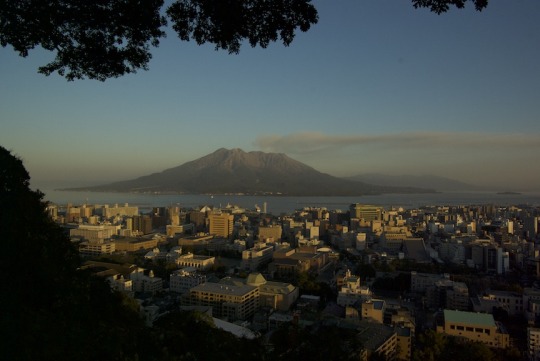
A similar shot from the manga is here in chapter 197.
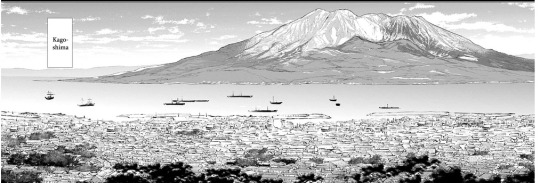
Here is a bit more zoomed in photo showing how the city is right across from the volcano.
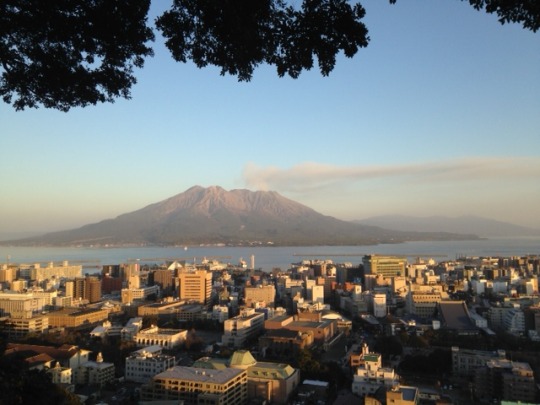
I was able to take the ferry across to the volcano a quick 15 minute ride. The volcano was a separate island until an eruption in 1914. Hence the name of Sakurajima even though it really isn’t an island (-jima) anymore. Interestingly, during Koito’s time (pre-1914), the volcano was dormant for most of the previous century but since they were growing the crops that thrived on the volcanic soil they were more than aware of the power of the volcano.
Here is a picture of one of the four ferries in action. These had space for regular passengers as well as cars for the lower decks.
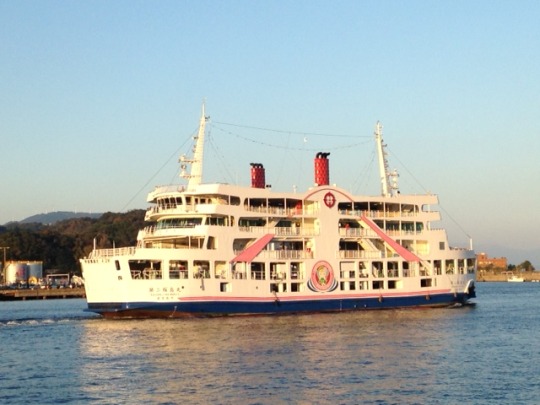
The entire bay and surrounding area are a large caldera. I’m failing to explain this well, but the volcano really is a major presence in the area. Kind of like how you feel when you see Mt. Fuji, Niagara Falls, the Grand Canyon etc but more personal. This is from the lookout point on Sakurajima. The volcano rises up in the background.

From the viewpoint you can look back across the bay towards Kagoshima. It was cloudy and overcast the day I visited the volcano; this is looking towards where Sengan-en is.
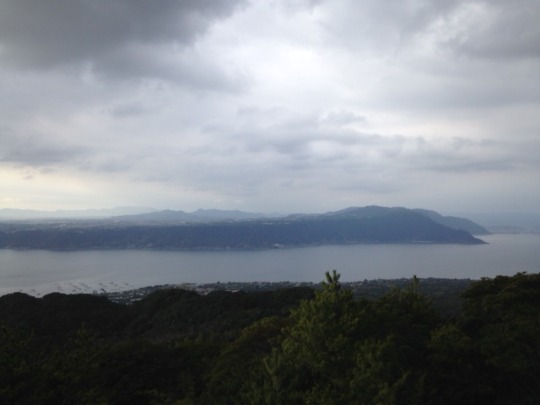
This is looking south towards the base of the bay eventually leading toward the ocean (it curves towards the left for the ocean).
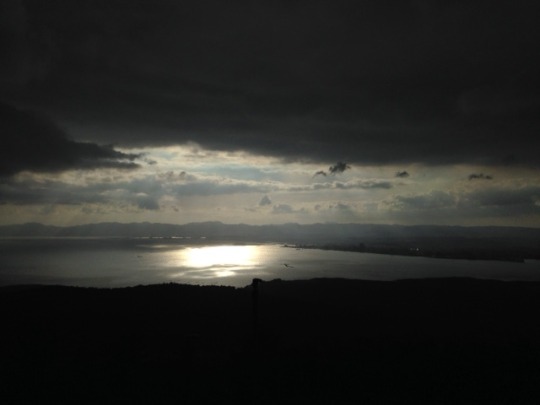
As we took the ferry back to Kagoshima port, the sunset highlighted the cloud and ash covered top of Sakurajima.
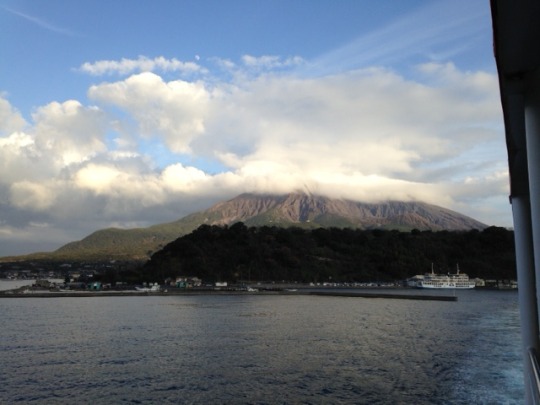
What I’m really trying to highlight is how Sakurajima is a fundamental part of the Kagoshima area (it is part of the city) and it has influenced this area for a long time.
Unrelated, there are lots of stray cats on Sakurajima that are friendly and like to be petted. About 50% of the population all have these stubby tails as I got this shot of an orange and black cat with the volcano in the background. I did pet this cat. My brother also petted some of the cats too.

With all of the things that I learned in my visit to Kagoshima, I will use them to try to understand parts of Koito’s character and what may happen in the future for his character.
1.) Koito as a Satsuma elite -
It became very clear to me visiting museums and walking around the city that Kagoshima is a very European influenced city and prized including a Western education. My Mom also remarked that it appeared much more diverse in architecture and more Western looking (and she had no idea that I was observing this for my meta).
It is no surprise that Koito would have been a well educated young man and also interacting with foreign visitors on a regular basis. Before his older brother died he sounds like he was energetic but likely much more well behaved than his 14-16 year old self. Once he realized he wanted to go into the Army after his “rescue” by Tsurumi, he was an excellent student and excelled at his courses and passed his exams to enter the military college.
He trained in Jigen-ryu and based on his skill he has shown so far in his fight with Sugimoto on the airship and when he attacked the random Russian prisoner. Even if he was a wild child, he must have kept up the practice as demonstrated when he encounters Tsurumi in Kagoshima. He states that he’s the son of an important man, so he’s of course using that to his advantage and he’s upset. (special thanks to @goldenkamuyhunting for letting me use the new volume 20 pages!).
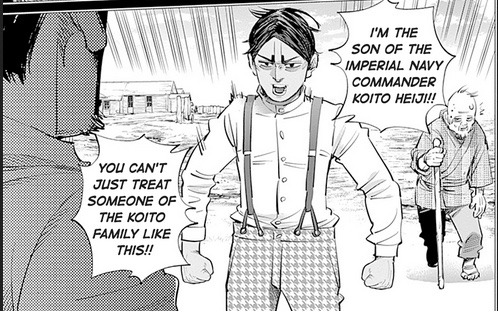
He then challenges Tsurumi with the old man’s cane instead of a sword. Sure he loses for all sorts of reasons - using what appears to be a lightweight cane, letting himself get overly emotional . . . the fact it is Tsurumi.
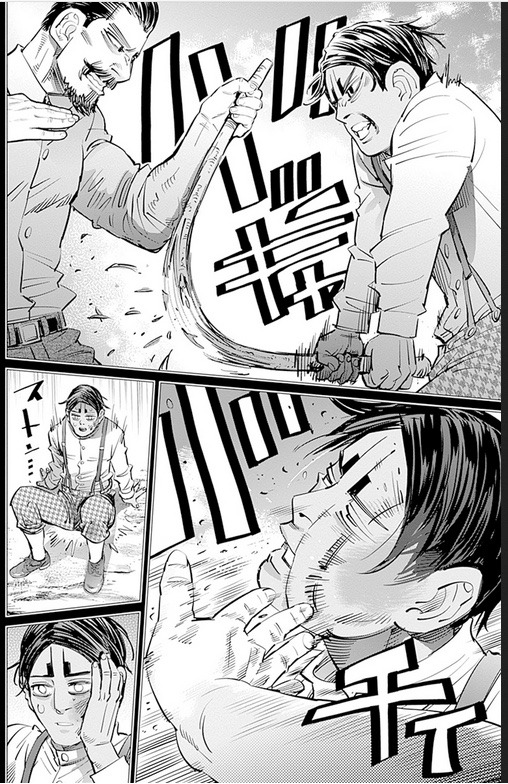
But after Tsurumi slaps him and leaves him in shock both failing to defeat him and using jigen-ryu, Tsurumi flatters him on his form. I take this to imply even if he is rebelling, skipping school and whatnot, he’s still practicing his jigen-ryu.
Previously, many of us avid readers of the series wanted Sofia and Koito to meet in Karafuto as we wondered if he was fluent in French as required for a military officer. However, after leaning that many people from Satsuma were aligned with the UK and also interacted with the USA around this time, I’m wondering if Koito can speak English instead. Tsurumi purchased weapons from a foreign arms dealer, Mr. Thomas (chapter 31). It is pretty damn obvious with the name of Thomas this man is an Anglophone. Though he’s based on a Scottish man, so he’d have a unique accent.
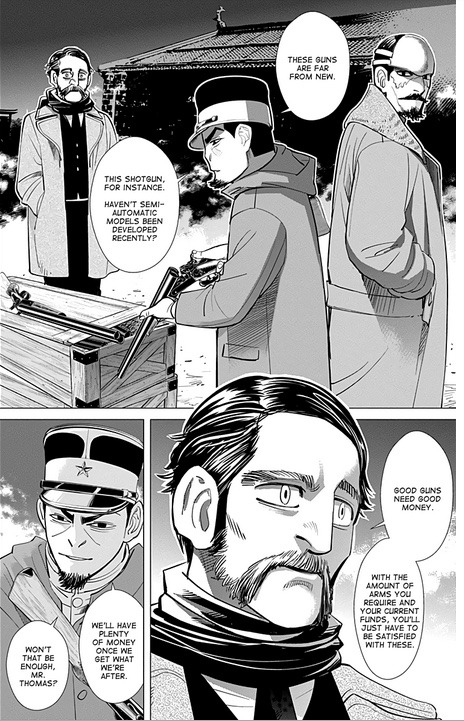
It is clear in this chapter that only Tsurumi and Tsukishima are meeting with Mr. Thomas in an isolated location. Based on the fact that Tsukishima and Tsurumi are both speaking with him, I would assume that they are speaking Japanese. This does not rule out that they also corresponded with him in English as well. I wonder if Mr. Thomas will reappear in the manga again as an arms dealer. Will the Anglo-Japanese relations of that time period come into play?
@goldenkamuyhunting has previous written about the fact that Mr. Thomas is likely based on Thomas Blake Glover a very successful merchant and business man in Japan who started out in Nagasaki. He also was one of the allies of the Satsuma domain families and involved in sending the students abroad to the UK.
Since Glover was more than willing to work with those in the Satsuma and Choshu domains, eventually leading to the overthrow of the shogunate government, perhaps we are to read that he’d be okay with another rebel faction in Hokkaido? Or since he became successful through relations in Kyushu does Koito Sr. know him?
2.) Koito is a citrus fruit.
This is a bit of an unusual angle, but I’m going to follow Noda’s lead here. Koito refers to his older brother as a Sakurajima daikon. It is clear that was his teasing nickname for his older brother, but it also something that he associates with his brother as a way to remember him now that he is gone.
If Koito Heinojyou is a large white daikon, than there are two options for Koito Otonoshin; sweet potato or mikan/satsuma orange. Sweet potatoes are more of a commoner food (alternative to rice) so a mikan makes more sense. I’m sure rich people still ate fancy sweet potato things, but likely in 1900 not all commoners could eat all the citrus grown in the area. Fresh fruit is always expensive.
Citrus fruits are brightly colored and energetic. All of the ones in Kyushu are various shades of orange and yellow. The mikans are a rich orange and are sweet and tangy. The aren’t a root vegetable like daikon or sweet potatoes, they grown on trees. Citrus need lots of care and attention to thrive. Citrus can only grow in warm climates and until modern industrial agriculture are in coastal regions (we are not discussing the central valley in California for various reasons). They also have fragrant flowers and are associated with people who are fresh, exciting, colorful and energetic. When you eat any type of citrus; lemon, lime, grapefruit, pomelo, yuzu, mandarin, mikan, clementine . . . etc no one would describe the flavor as weak, dull, or subtle. They are sweet, tangy, sour, bitter and aromatic as well. There is a lot of emotion and depth in citrus.
He’s charming and canonically an attractive male character. Sei Kobiyama has tweeted about this when the Vol 16 cover came out and the red eyeliner is linked to him be an attractive young man.


He’s got upper class manners and enjoys his Russian tea time.
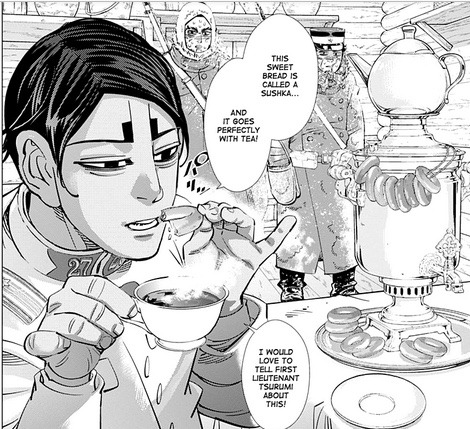
Sei Kobiyama also noted that even when he tries to be angry and mean he doesn’t swear like the rest of the cast.

His deadpan upon his realization that he set Sugimoto up with his sabre blade.

The look of absolute horror that he may rip his skin off when trying to remove the cold hammer. I feel sorry with the volume edit where it is clear Sugimoto chased after him and pissed on him . . . why didn’t anyone suggest pouring some hot tea on his hand?
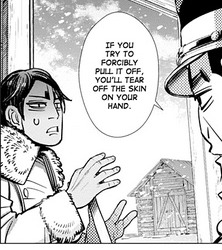
All of these aspects of citrus apply to Koito. His brother was a solid first son, well behaved and stable just like the large Sakurajima daikon. He is a native of the area, but his mother’s background is reflected in him as well. When Koito is rescued by his father and Tsurumi, we learn that Koito Heiji is also a much more dramatic and energetic man rushing in to save his son. These are passionate men who when at their best radiate this energy and warmth.
Koito’s older brother is a boring old root vegetable while he and his father are clearly sassy citrus, needing their sunshine and pruning etc etc. They may be capable men but face it, Koito Sr. spent too much time hiding his feelings and Koito is a very pampered guy who is very concerned about his appearance. Sure, he wanted Tsukishima to get his hand mirror so they could locate Vasily . . . but . . .

. . . but not without fixing his hair before looking!
And one of my absolute favorite jokes in the entire manga. Yes, I think Noda watched the classic comedy/parody “Spaceballs” for inspiration as a Princess has a ton of luggage that she insists on taking with her to the annoyance of commoners who rescued her.
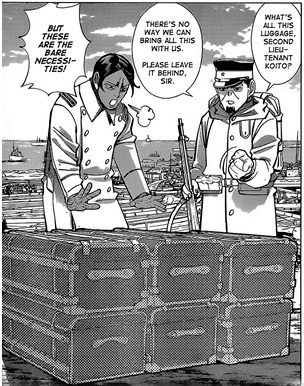
I predict 50% of this contains personal care products for him. He’s so far north he’ll need to moisturize, and his hairstyle likely requires all sorts of products to keep it in such tip top condition. Okay, I’m jesting a bit, but I’m sure a lot of his stuff is for him to pamper himself.
Maybe as things change he’ll become a sweet potato? His hair color is pretty much the same color as one of the local Satsuma varieties - I kind of want to send Noda a message if Koito’s hair color is sweet potato colored. According to Sei Kobiyama he’s supposed have crow feather colored hair, which is considered very beautiful, but I see sweet potato.
3.) Koito comes from a region where people have recently questioned authority.
The most famous individual who helped shape Meiji era Japan and was from Kagoshima was Saigo Takamori. Tsurumi (as Hasegawa) tells Wilk, Kiro and Sofia about the 3 main founders of modern Japan. Sofia was compared to Saigo and he is from Kagoshima. Despite the fact that he lead to the change in government, he found himself in disagreement with the Meiji government and eventually returned to Kyushu to lead dissatisfied samurai of the region in a rebellion against the government.

It was clear visiting Kagoshima that he’s still a very famous and respected man, with many of the sites that you can visit are related to him. There is a statue of him along the art & culture road and he’s found everywhere; in shops, on o-miyage, products. If you see his statue in Tokyo’s Ueno Park, he’s portrayed in a less positive fashion (he’s got a bit of a beer gut as we’d say in English).
What is interesting is that Saigo worked in the Meiji government for some time. He didn’t just immediately fight against those he should be serving. Instead, he worked as a part of the government for some time and his somewhat both logical yet flawed ideas attempted to deal with the rapid social and societal change that the Meiji government was forcing upon everyone. He however, seemed more focused on the military than industrializing which would be counter to what he would have ultimately wanted. I’d say the soft power of the Shimazu family was much more forward thinking as they wanted to pursue industrialization.
Koito has spent a long time of his “focused” life trying to serve Tsurumi and prove to his father that he will be a good soldier. With the flashback in chapters 197-200, and his confrontation with Tsukishima in 210, he almost had a nervous breakdown.

He started to put things together and when Tsukishima threatened him and told him how Ogata killed Hanazawa he just was in complete shock. He was screaming in a non-Satsuma accent as he just did his best to behave how Tsukishima would anticipate he would behave.
I think in part when he got stabbed by Sugimoto when Asirpa escapes is in part due to the fact that he was still in shock. He lacked the usual energy and passion and overall “Koito-ness” that he’s shown in many other chase scenes. I honestly felt Koito was going through the motions when pursuing Asirpa and Sugimoto. Based on his mistake of approaching Sugimoto, I really think this adds to how he wasn’t quite with it during that chapter. He didn’t know what to think or do so he just went with the flow and relied on his training to cover up the fact that he clearly was a mess inside learning about Tsurumi. Even though he’s quite passionate and emotional at times he clearly does hold some of his emotions in and indicated by his distance/sulking post Ogata escape.
He stubbornly tries to get Tsukishima to keep pursuing Sugimoto as he weakly tries to waive him off. He’s trying his best to be a tough Satsuma Hayato (which I think is what he thinks he should be doing/acting as), and he made a mistake fighting Sugimoto even though he did the best he could do. He’s likely feeling very ashamed and still trying to determine what is going on with Tsurumi anyways. I also agree with Sei Kobiyama here that even though he’s a Satsuma Hayato, he’s too “nice” to really be one. I just keep coming back to him and Enonoka.

When we finally learn about his health he tells his father that he’s pitiful. Is he pitiful since he tried to stop Sugimoto? That he realized he’s been used by Tsurumi since he was 14? That Ogata gave him enough information that he sees what Tsurumi is doing isn’t for the benefit of the military and instead it is for Tsurumi’s own personal goals? The good thing about Koito being injured is it will give him a lot of time to think and rest. I really think him cornering Asirpa less than 12 hours after he learned part of the truth from Tsukishima was not a good thing for him.
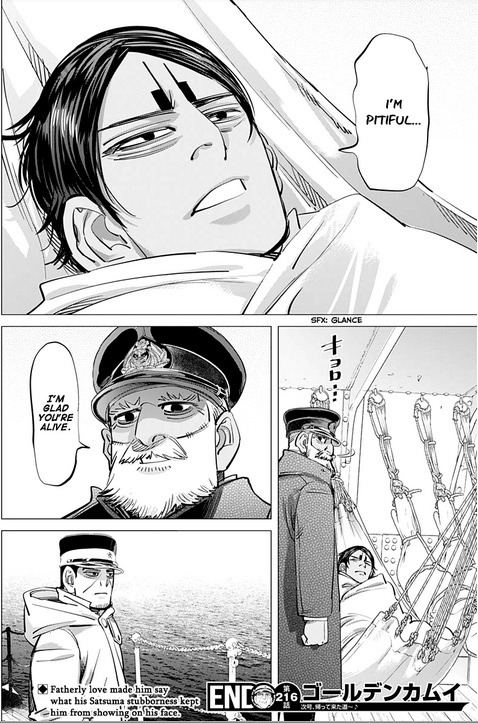
That pained look on his face as his father looks away before telling him that he’s glad that he’s okay . . . and thankfully when Inkarmat finally reappears, she’s giving him his daily fortune as well as Tsukishima. His blush likely indicates he’s got some sort of crush on Inkarmat. He’s an extroverted guy, so he’d likely get along with someone like her. Even though he doesn’t interact with many females, I get the feeling that he relates to them better than men. I just think of how he was so sweet and respectful of Enonoka and he clearly enjoys Inkarmat’s company. I get the feeling that Inkarmat in canon is supposed to be a very attractive woman and we know she is both charismatic and independent.

Koito has kept himself going by trying to follow the military order and establishment up to this point. For him to question the system and go against Tsurumi, he will have to shatter his entire view of the military and how it operates.
I think Koito will want to seek out the truth as to what is really happening with Tsurumi. We know when he focuses on something he’s successful - just dealing with Tsurumi is going to be very difficult for him.
Thanks to @goldenkamuyhunting, I was able to see this change to volume 20 chapter 200. Koito is able to help himself up by himself from the blows that Ogata dealt to him. Battered and bruised he is able to exit the small hospital and we see a determined yet rough looking Koito. He gives the feeling of a man who wanted to catch Ogata to ask him more. I think Koito is thinking “What do you mean about the Manchuria Railway Ogata? What happened to Hanazawa? Why do you know the word a Russian kidnapper told me?” . . .

We later learn in chapter 210 that Ogata mentioned the Mantetsu (Manchuria Railway) so that Koito would link Hanazawa’s death to Tsurumi’s plans. I think Koito wanted to know what Ogata was referring to. He’s also likely had to rethink his opinion of Ogata based on chapters 200 and 210. He is an officer in the military, he’s an educated elite and he’s putting together big picture concepts that Ogata is dropping him hints about. I think he’s got the potential to be a clever character as well if he can gain confidence in himself. In the revised flashback with Tsurumi when he was 14, he was confidence using his father’s name. He needs to be 100% confident in himself. I hope he can get there!
Really the biggest determent to Koito’s character is how his bratty rich kid attitude prevents him from connecting with others. Time and time again he is not nice to others since he can get away with it. This is the aspect of Koito’s personality that I like the least. The only time that I liked it, is the fact that he is the only character to call out Sugimoto’s bullying and to go head to head with him. I think the rest of the characters may want to stand up to Sugimoto, but they can’t since they aren’t as privileged so they don’t know if they can. Koito however, just uses his baseline sense that he can push back at Sugimoto since “How dare he?” treat him poorly. His reasoning is a bit flawed but his response is what I would like to see others do as well. He really is just like Ogata in that regard, both of them have personalities that developed as a result of their background that makes it hard for others to connect with them. Ogata since he’s so distant refusing to connect with others and being too sarcastic for a lowly superior private and Koito since he’s just used to others obeying him as a result of his family and privilege.
So to stick with the local food analogy - I want Koito to go from being a citrus fruit to a sweet potato. Still important but much more humble.
Another Kagoshima analogy would be that Koito is like Sakurajima. His true potential and skills are dormant, but like the volcano does in his future, 1914, he reaches his full potential and is an amazing leader and force within the country.
Well that is all for my Kagoshima-Koito post. I hope you’ve enjoyed it. I felt that visiting Koito’s hometown gave me a better perspective on him and where he came from. This is something I wouldn’t have know if I hadn’t visited it! I had a great time visiting and learning about Koito, so if you have a chance to visit do so! If people are more interested, I could do a more detailed Koito tourism post in the future.
#golden kamuy#golden kamuy meta#koito otonoshin#koito heiji#koito yuki#koito heinojou#kagoshima#satsuma#satsuma hayato#sakurajima#tsurumi tokushirou#tsukishima hajime
38 notes
·
View notes